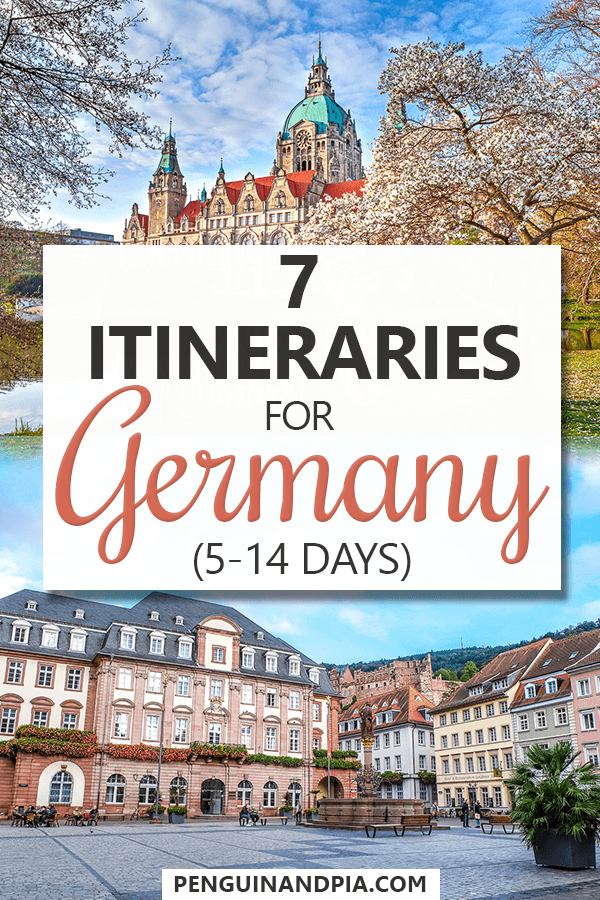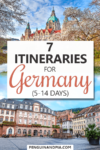Plan Your Perfect Germany Itinerary with These Detailed Templates!
If you’re looking to plan the perfect trip around Germany, you are in luck! We’re passionate about exploring Germany because it’s a great country – and because Lisa is German!
Jokes aside, we’ve been lucky enough (and have made it a point) to see lots of different parts of the country – from the sea in the north to the mountains in the south. That said, Germany can be a tough country to plan a route or road trip through because there is just so much to see and do!
So, whether you’re looking for the best week in Germany or a Germany itinerary that covers 5 days or 14 days – here’s our master guide with 7 detailed Germany itineraries by train and/or by car! We’ve got cities, attractions, hotels and accommodations, directions, and distances to help you plan the best Germany travel route for you!
We’ve got other great posts to help you plan a visit to Germany:
Table of Contents
Things to Consider When Travelling in Germany
Before you plan your trip to Germany, there are some things that you should know and keep in mind to make planning easier and to have a successful trip. While you probably know that the currency used in Germany is the Euro, here are some other topics that you should consider as well.
Best Time of Year to Visit Germany
Germany is actually a destination that you can visit year round – but it is important to plan accordingly and go in with the right expectations. If you’re planning a trip during the spring – let’s say from March to May – you could absolutely have beautiful weather… but it may also just rain a lot.
Unfortunately, the weather can be quite difficult to predict. However, as long as you prepare for different possibilities, you can have a great time no matter the weather! Generally you can say that Germany has a moderate climate with cool and rainy winters (more snowy the farther south you get) and warm – but not overly hot – summers.
July and August are usually the warmest months with an average temperature around 20°C. However, there can be days where you have 30°C. Of course, this can vary depending on the exact location you’re travelling to. Often, it is colder by the north coast than it is farther south.
We would honestly recommend that you avoid visiting the country in July if you dislike crowds since this is when the majority of kids are on their summer break from school. As a result, some cities can get quite busy.
Typically, we would recommend travelling in May or June and then from the end of August until the end of September (or even the middle of October). However, there is also a great reason to plan a Germany trip during the winter because of the many beautiful Christmas markets that you could visit at that time of year!
Public Transportation in Germany
Public transportation in Germany is quite good, especially when compared to North America. Yes, sometimes us Germans like to complain about the “Deutsche Bahn” – the German train company – but at the same time we are also super glad that it exists and works well.
If you’re wondering: Yes, all the itineraries mentioned below can absolutely be done if you want to take the train (minus the odd day trip to a castle here and there). If you want to check a train connection and/or buy tickets in advance you can do so on the DB Website. Alternatively, you can also download the DB app to your phone. We both have it and use it regularly.
As an alternative to the train, you can sometimes also use the bus to get from one city/town to another. Since 2013 (before this date it wasn’t allowed), long distance buses have established their presence in more and more cities and are now a popular way to get around for people who are more conscious of their money.
Unfortunately long distance train tickets can sometimes get quite expensive if you don’t book in advance – so the bus can be a good alternative in some cases.
The most popular long distance bus company in Germany is probably Flixbus. We have also used them multiple times to get between cities. If you want to look at the schedule and/or book a ticket, you can do so on their website.
In addition to the trains and long distance buses, the public transport within the cities is also usually pretty good – especially in bigger centres. Many of the cities – or transport associations – have their own transport apps. So, if you know where you are going and plan on using the local buses, trams, metros, etc. then downloading the local transport app would be a great idea!
Car Rental in Germany
If you want to rent a car and plan a Germany road trip, then that is certainly an option as well. Driving in Germany is generally pretty safe and people are not usually as reckless as in some countries in the south of Europe. However, it can get a little crazy in bigger cities like Berlin or Munich – especially if you are not used to driving in bigger centres.
In Germany, you drive on the right side as it is done in the United States, Canada, and many other countries as well. You have probably heard of the “Autobahn” – that’s simply the German name for our highway system. If you follow any of these itineraries, you’ll drive on many different highways.
While it is true that there is no speed limit in some parts of the Autobahn, there are lots of sections where there are actually speed limits in place. You can usually find limits imposed at/around construction zones along the way – so don’t think you can just speed all the time.
And PLEASE don’t drive on the Autobahn like you would on a highway in the United States or Canada – pass on the left and then get back over. If you’re going slower than other cars, there’s no need for you to be in the left (or even in the middle) lane. You can probably tell that this is something that Lisa complains about in Canada frequently, haha.
Since Germany is such a popular destination, there are lots of different rental car agencies to choose from. You can compare prices from different agencies for the duration of your trip with this handy rental car comparison tool. Please make sure to read the fine print so you know whether you need extra insurance, etc.
Also please be aware that many people in Germany drive cars with a stick shift. Rental cars with automatic transmissions exist, but the numbers available are usually lower and these cars might be slightly more expensive.
We’d also recommend that you reserve an automatic car well in advance if you need one – just so you can make sure that one is available for you. It probably wouldn’t be fun learning how to drive a stick shift while on a road trip in a foreign country.
Travel Insurance for Germany
If you’re planning a trip to Germany and you’re not from another EU country, then you should make sure to get travel insurance for the duration of your trip!
While you’ll probably be fine, accidents do happen and it could get really expensive if you’re not covered. That’s why we always travel with insurance.
If you live in another EU country and have health insurance there, you can get the blue health insurance card with which you are covered in other EU countries in emergency cases, as well.
If you don’t have that option – or are from outside of Europe – we recommend that you get private travel insurance.
Germany Itinerary 5 Days
If you only have a few days to travel through Germany, then have a look below at the two 5-day itineraries we have created. For these itineraries, we have assumed that you are not already in the country so they all start and end in bigger cities.
This should help make it easier for you to fly in/out of an airport with good connections if you are coming from overseas.
Depending on your preferences, you can choose between a trip through the northern part of Germany or a trip through the south of the country (mainly Bavaria). If you are interested in bigger cities and/or harbours, then we’d recommend the northern route.
In case you prefer half-timbered houses and beautiful old towns, then you should have a look at the southern route instead. Of course, you can always modify any itinerary to better suit your interests!
Germany Itinerary 5 Days – North
This 5-day Germany itinerary through the northern part of the country can certainly be considered a “sampler-type” of itinerary since you get to see the two biggest cities in the country – but not much more than that.
That’s completely fine though – you can only see so much in five days anyway. If you are interested in bigger cities and don’t have more than a few days, then this itinerary would be great for you!
The total driving time for this itinerary would be about 5 hours 30 minutes with a total distance of approx. 520 km. Of course, this can change depending on the route you are taking and the time of day you are travelling. Commuter traffic could add quite a bit of travel time to your journey.
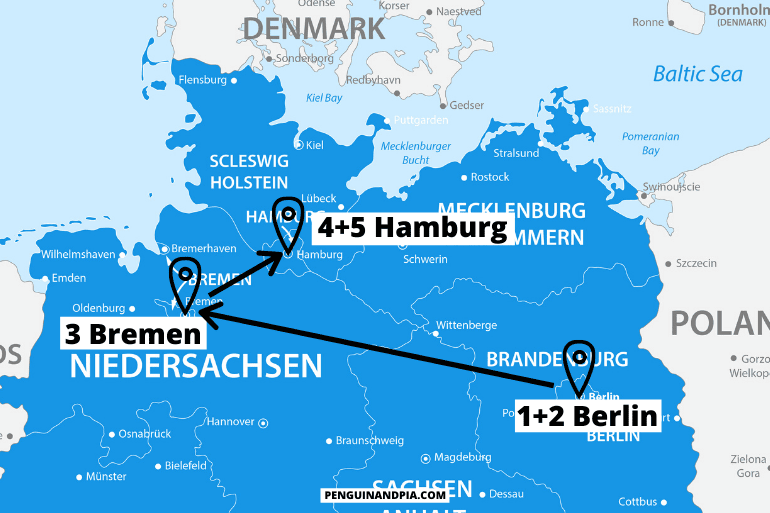
Day 1+2: Berlin
Day 3: Bremen
Day 4+5: Hamburg
Day 1+2: Berlin
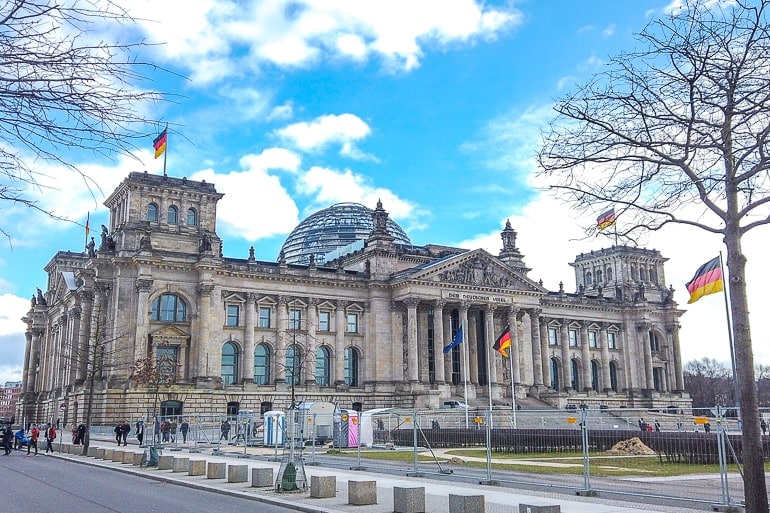
Berlin is a great place to start your adventure since it is the German capital, has multiple airports close by, and has really good train connections.
Since Berlin is such a popular tourist and business city, the car rental industry is well established and there are many different rental agencies to choose from.
— Compare prices from rental car companies in Berlin here
However, since you are only visiting bigger cities on this relatively short itinerary, we believe that a rental car is probably not necessary. Instead, for this trip, it might make more sense to take the train.
Since Berlin is such a big city with lots of things to do, it is worth it to spend (at least) two days in the city. So, remember to book your accommodation in Berlin for two nights.
Accommodation in Berlin: Berlin is a massive sprawling city with loads of different areas to stay and different accommodation options. You can check here for accommodations and hotels in Berlin.
If you are travelling to Berlin with a car, you’ll need a place to park. Check out Park Plaza Wallstreet Berlin Mitte for a stay right in the middle of the city close to Museum Island and other top attractions. It also has a tasty breakfast. Park Plaza has free parking on the street near the hotel (if available) or else it’s for a fee (but a reasonable price considering you’re in the middle).
If you are arriving into Berlin by train, you can check out NH Collection Berlin Mitte am Checkpoint Charlie. Located in the city centre right near the top sight “Checkpoint Charlie”, this popular hotel is in the heart of the action/attractions and is easy to get to via modes of public transit (metro – called the “U” for U-bahn).
If you are searching for a hostel/hotel, check out PLUS Berlin. Located over near the East Side Gallery (the piece of the Berlin wall with the artwork on it), Eric stayed here and really liked it! It’s also very easy to get to using public transit and is close to other areas to go out, etc.
Must-see Attractions in Berlin:
- Brandenburg Gate
- Reichstag
- East Side Gallery (Berlin Wall)
We have also written a whole article about classic tourist attractions in Berlin in case you’d like some more inspiration. If you’re looking for some tips on how you could spend a day in Berlin, have a look at our One Day in Berlin Guide.
Day 3: Bremen
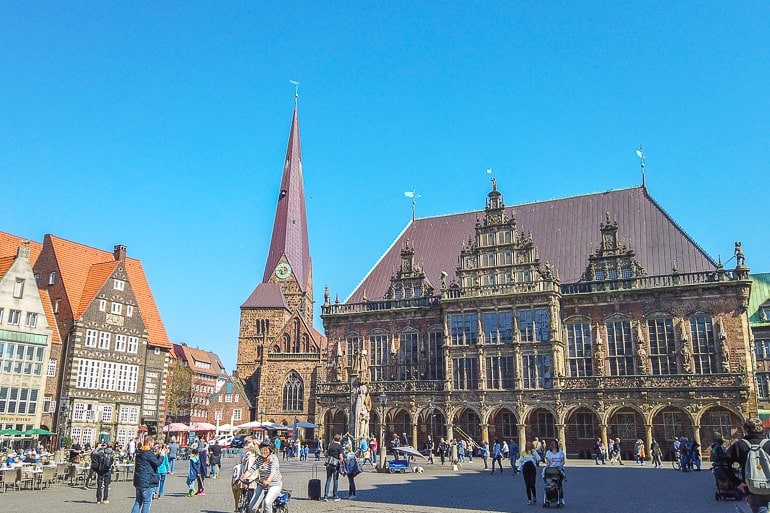
On the third day of your 5 days in Germany, you’ll head for Bremen. We’d recommend that you do the drive/train ride in the morning so you have enough time to explore the city once you get there.
Bremen is a hanseatic city with a nice old town – the market square with the town hall and the cathedral is especially popular. In German-speaking countries, the city is also known for a tale called the “Town Musicians of Bremen” by the Brothers Grimm. You’ll come across the animals of the tale (donkey, dog, cat, and rooster) many times as you stroll through the city.
The drive from Berlin to Bremen will take you approximately 4 hrs 10 min by car, but only around 3 hrs by train. If you take the train, try to book in advance if you can as this will usually save you some money.
Accommodation in Bremen: Bremen is a popular city to explore and it’s also on the larger side so you’ll find plenty of accommodations to suit your needs. There are hotels in the city centre/old town which put you within walking distance of the river and top attractions. You can check here for accommodations and hotels in Bremen.
For a popular choice in the historic middle, you should check out the very popular Radisson Blu Hotel Bremen. Funny story – we know there’s underground parking because we parked there when we visited Bremen by car.
If you want to stay closer to the train station just outside the historic centre (but still very central), check out the Dorint City-Hotel Bremen. This lovely and also very popular hotel is close to the pretty Windmill and flower gardens and has water views just outside the old city walls.
Must-see Attractions in Bremen:
- Marktplatz with Town Hall and Cathedral
- Böttcherstraße
- Schnoorviertel
If you want some more tips for Bremen, have a look at our detailed Things to do in Bremen Guide.
Day 4+5: Hamburg
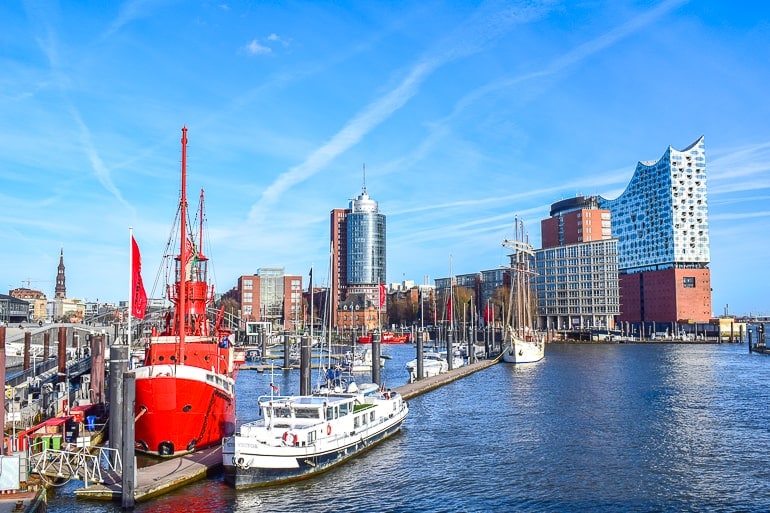
Hamburg is the second-biggest German city and the last stop on this short itinerary. We have been to Hamburg numerous times now and it is actually one of our favourite bigger German cities. You’ll find that the atmosphere of the city is very different than in Berlin. Not necessarily better or worse – just different.
Interesting (and slightly irrelevant) fact: The cities you visit on this itinerary are the three city states that exist in Germany in addition to the 13 area states such as Bavaria, Nordrhine-Westphalia etc.
The drive from Bremen to Hamburg is actually pretty simple and should only take around 1 hour 30 minutes by car and just around 1 hour if you take an ICE (fast train). The train connection between these two cities is great with trains running pretty frequently. That should make it quite easy to find a train connection that works for your schedule.
Accommodation in Hamburg: Hamburg is popular city with loads of different accommodations and areas to stay in. You can check here for accommodations and hotels in Hamburg.
If you are travelling to Hamburg with a car, you might want to check out the Mövenpick Hotel Hamburg. Located in an old water tower, this unique hotel has a number of cool features with stunning views and parking onsite. It’s very popular – and also close to public transit for getting around!
If you are travelling to Hamburg by train, ARCOTEL Rubin Hamburg is a great hotel option for you to check out. Located in the cool area of St. Georg, you can easily walk to the hotel from the train station. It’s also walkable to other parts of the city centre and other attractions.
If you are looking for a hostel in Hamburg, you might want to check out Generator Hamburg as a reliable and popular hostel stay close to central station and the heart of the city.
If you want more details about accommodations in the city, we have a more detailed guide on where to stay in Hamburg.
Must-see Attractions in Hamburg:
- Town Hall
- Speicherstadt
- Elbphilharmonie
- St. Pauli Piers
As one of our first ever articles on Penguin and Pia, we actually wrote a short Hamburg Guide. Have a look if you want some more Hamburg inspiration. Unfortunately it’s not nearly as detailed as our newer article – looks like it’s time for an update!
Germany Itinerary 5 Days – South
If you would like to explore the southern part of Germany instead of the north, then we would recommend the following 5 days Southern Germany itinerary. Compared to the northern itinerary, this trip includes stops in some smaller towns and cities. So, if you are interested in seeing some places of various sizes, beautiful old towns, and maybe a castle, then this might be a good itinerary for you.
The driving distance of this trip is just around 680 kilometres with a total driving time of approx. 7 hours. Depending on your mode of transportation, this can – of course – vary slightly.
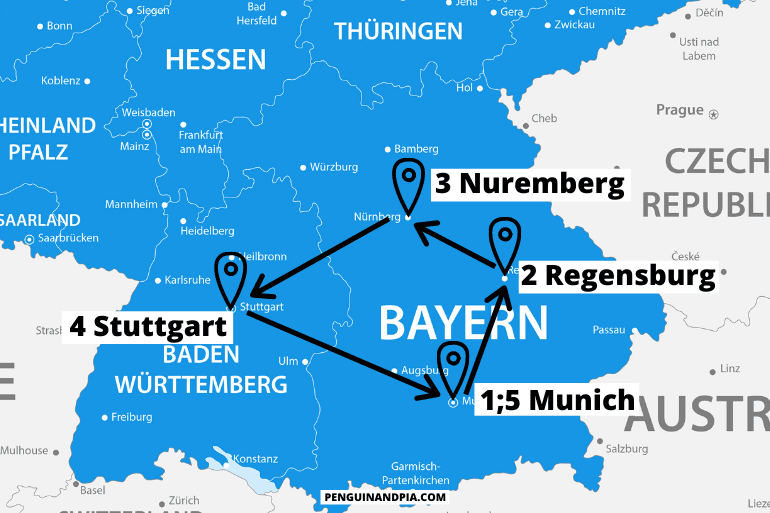
Day 1: Munich
Day 2: Regensburg
Day 3: Nuremberg
Day 4: Stuttgart
Day 5: Munich
Day 1: Munich
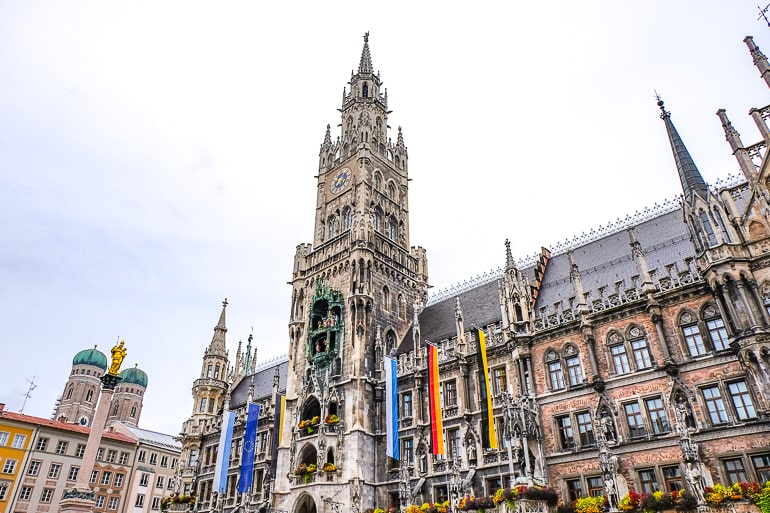
We are starting (and ending) this itinerary in Munich since it is an easy airport to fly in and out of from other parts of the world. If you are coming from another part of Europe by train, the connections to Munich are also usually pretty good.
Munich is the third-biggest German city and a very popular tourist destination. International travellers often mainly know the city because of the Oktoberfest which happens every year from the middle of September until October.
However, there is so much more to do and see in Munich than just the “Wiesn” (as the Oktoberfest is sometimes called as well). We are always happy to return to Munich because there is just so much to explore.
If you are thinking about renting a car for this itinerary, then you’ll be happy to know that it is quite easy to get a rental car in Munich. You can either pick it up directly at the airport after you land (if you arrive by plane) or in the city centre before you head to the next stop on this journey.
— Compare prices from rental car companies in Munich here
Accommodation in Munich: Munich is very large and popular city so finding a place to stay is no problem. The issue becomes that there are too many places to choose from! That said, you can check here for accommodations and hotels in Munich.
Specifically, we stayed at the very popular H2 Hotel München Olympiapark and we would highly recommend it for the value for money. The hotel has nice, cozy rooms, a super great breakfast buffet, and has a metro station steps from the front entrance to take you to the city centre.
There’s also onsite parking which makes this hotel perfect if you are travelling to Munich by car. The famous Olympic Park and BMW Museum are close by, too!
If you want to stay a little more in the city centre, then check out the Platzl Hotel Superior. This trendy hotel is in the heart of the Old Town just steps from top attractions like Marienplatz and the famous Hofbräuhaus. It’s also easy to get to the central train station either walking or on the metro.
If you are looking for more details on accommodations in this massive city, we wrote a detailed guide on where to stay in Munich.
Must-see Attractions in Munich:
- Marienplatz with New Town Hall
- Olympic Park
- Victuals Market
- English Garden
We also have a great little guide on how to spend one day in Munich if you want more details.
Day 2: Regensburg
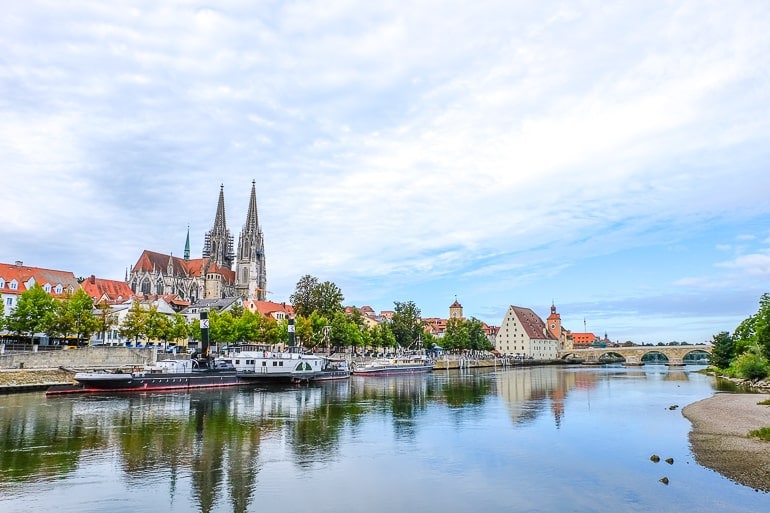
On day two of your trip you’ll be on your way to Regensburg, a small city in Bavaria on the Danube river. Due to its location by the river, Regensburg is a popular stop for people on a river cruise. So don’t be surprised if you see many different tour groups in the Old Town.
We recently spent a couple of days in Regensburg to get to know the city better and enjoyed our time there. One of the highlights is the Old Stone Bridge in the city centre which was built in the 12th century. We actually filmed a small YouTube video in Regensburg – which you can watch here if you are curious about what the city looks like.
The journey from Munich to Regensburg takes approximately 1 hr 20 minutes by car and around 1 hr 30 minutes by train. If you decide to travel by train – and especially if you are travelling with other people – we would recommend that travel with a “Bayernticket” (Bavaria Ticket). This ticket for train travel within the state of Bavaria usually allows you to save some money compared to regular prices.
Accommodation in Regensburg: If you are staying a night in Regensburg, you’ll have a number of great accommodations to choose from. To get started, you can check here for accommodations and hotels in Regensburg.
When we visited the city, we stayed at the Holiday Inn Express – Regensburg and really liked it. It’s a newer hotel and it really shows. The breakfast was excellent and there is even an onsite parking garage if you are travelling with a car. It’s not in the Old Town or near the river – but we did walk there one day and it only took about 15 minutes.
If you are travelling by train and you are on-foot, then check out the Altstadthotel Am Pach. This simple hotel is located right in the heart of the old town so you’re close to everything there is to see and do in Regensburg – including the beautiful Danube River. They also have breakfast included.
Must-see Attractions in Regensburg:
- Old Stone Bridge
- St Peter Cathedral
- Haidplatz
We are currently still working on our Regensburg Guide – but we’ll link it here once it is published.
Day 3: Nuremberg
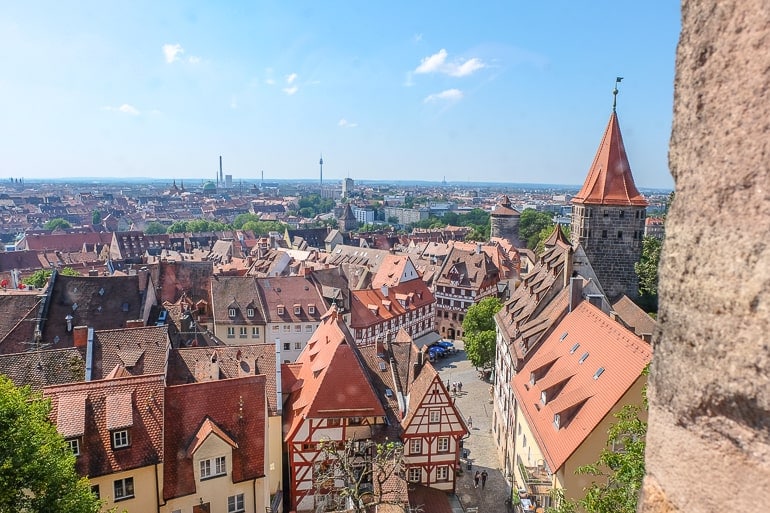
On the third day of this 5 day Southern Germany itinerary you’ll drive – or take the train – from Regensburg to Nuremberg. Nuremberg is a medium sized city in a part of Bavaria called Franconia. If you pay attention, you might notice that the dialect spoken here is quite different from that spoken in Munich and other places farther south.
Lisa actually grew up in this part of Germany so she has been to Nuremberg many, many times. Last year we also went to explore the city together and had a great time. Travellers from abroad mainly know the city for the Nuremberg Trials which took place there after World War II. You can certainly learn alot of history in this German city!
Since Nuremberg is quite close to Regensburg the drive won’t be long – giving you slightly more time to explore the city.
The journey takes approximately 1 hour 10 minutes by car and between 1-2 hours by train depending on which train you take (some stop more often than others). Once again, a regional ticket – such as the Bavaria Ticket – will probably save you some money if you travel with more people.
Accommodation in Nuremberg: Since Nuremberg is a very popular city to visit in Germany, there are many, many places to stay scattered throughout the city centre and around it. You can check here for accommodations and hotels in Nuremberg.
When we visited, we stayed at Five Reasons Hotel and Hostel and we really liked it. Located just inside the medieval city walls, we were really close to the train station and yet also steps from top attractions like the Germanisches Nationalmuseum. The place was bright and great value for the price which we liked a lot.
Close to Five Reasons, we had friends stay at the Sheraton Carlton Nuremberg and they loved it. We actually saw it with our own eyes – it had a pool with views of the city among other perks. There’s also a parking lot right across from the hotel if you’re coming to Nuremberg by car. It’s walking distance to the old centre and the central train station so best of all worlds!
Must-see Attractions in Nuremberg:
- Imperial Castle of Nuremberg (Kaiserburg)
- Documentation Center + Nazi Party Rally Grounds
- Albrecht Dürer’s House
As is the case with Regensburg, we are also still working on our article for Nuremberg. Once it’s live, we’ll link it here.
Day 4: Stuttgart
Stuttgart is the capital of the German state called Baden-Württemberg and the only place on this itinerary that is not located in Bavaria. The city is mainly known for being a “car hub” since both Mercedes-Benz and Porsche have their headquarters there. There are also museums dedicated to both car brands.
Stuttgart is a bit smaller than Munich but there is still a lot to see. In fact, one day won’t be enough to see the whole city – but it’ll allow you to get a good first impression. Next to the car museums, you could visit some of the many green spaces and/or old buildings that the city has to offer.
Driving from Nuremberg to Stuttgart by car will take you approximately 2 hours 15 minutes. If you have the time, you could even take a small detour and stop in Rothenburg ob der Tauber, known for its picturesque Old Town.
By train, the journey from Nuremberg to Stuttgart will take between 2 hrs 10 minutes and 2 hrs 30 minutes – depending on the type of train you are taking. Try to book your ticket in advance if possible as this can save you some money.
Accommodation in Stuttgart: There are many places to stay in Stuttgart – especially in the city centre. You can check here for accommodations and hotels in Stuttgart.
If you’re travelling to Stuttgart with a car, check out the Abalon Hotel ideal. Located very much in the city centre, this popular hotel has an underground parking garage and offers a good breakfast selection.
If you’re travelling to Stuttgart by train, you can check out the Pension am Heusteig. This guesthouse-style accommodation doesn’t have parking but offers a great breakfast and is a doable walk or metro ride from the train station. Funny enough, these two accommodations are very close to one another!
Must-see Attractions in Stuttgart:
- Schlossplatz
- Mercedes-Benz Museum
- Staatsgalerie Stuttgart
Day 5: Munich
On the last day of your trip you’ll make your way back to Munich since it is usually easier to leave Germany through the Munich airport than smaller airports in the surrounding area.
However, if you don’t have to get to an airport – and/or are taking the train home – you could also stay an extra night in Stuttgart if you wanted. Both cities are worth spending an extra few hours in – so you really just have to see what works best for you.
If you decide to get back to Munich, then the journey from Stuttgart to Munich will take approximately 2 hours 20 minutes by car and just slightly less (2 hrs 15 minutes) by train.
Accommodation in Munich: We already went over accommodations in Munich in Day 1 of this itinerary. So, you can head back up for the full details – but we would highly, highly recommend the H2 Hotel München Olympiapark as great value for money with great breakfast, parking, and a metro stop outside the front door.
Don’t forget we also have our detailed guide on where to stay in Munich if you want to have a deeper look at accommodations in the city.
Must-see Attractions in Munich:
- Marienplatz with New Town Hall
- Olympic Park
- Victuals Market
- English Garden
We also have a post on spending one day in Munich if you want more details about the city!
Germany Itinerary 7 Days
If you have slightly more time to explore Germany, we have also created two 7 day Germany itineraries for you. Similar to the 5 day itineraries, we made two different itineraries since it’s pretty much impossible to see the whole country in just a week.
Instead of a northern and southern itinerary, this time we have focused on the western and eastern parts of the country. But please don’t read too much into that description – we use the terms quite loosely. As always, you’re welcome to modify any part of the itinerary to make it better fit your schedule/interests.
Germany Travel Itinerary 7 Days – West
For this itinerary, the total driving time would be around 14 – 15 hours and the distance would be slightly over 1100 km. For these calculations, we included the day trip to Monschau (and back to Cologne) as well as the day trip to Freiburg im Breisgau (and back to Stuttgart), which would be a longer day trip anyway.
So, depending on which day trips you decide to add on to (or remove from) this itinerary, your driving time and distance could be noticeably different than the estimates given above!
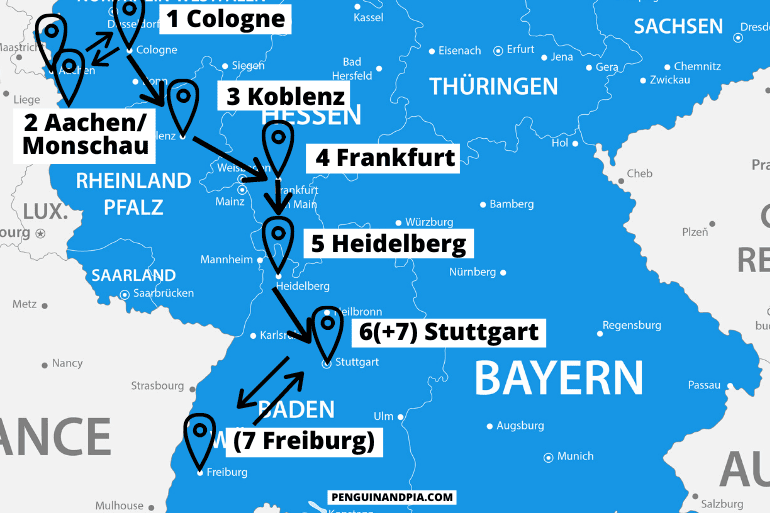
Day 1: Cologne
Day 2: Day Trip to Monschau/Aachen
Day 3: Koblenz
Day 4: Frankfurt
Day 5: Heidelberg
Day 6: Stuttgart
Day 7: Stuttgart / Day Trip to Freiburg im Breisgau
Day 1: Cologne
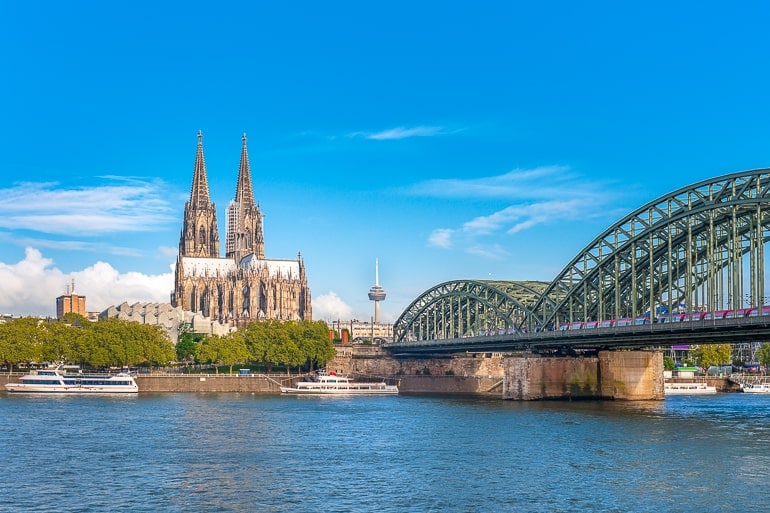
As we have already explained above, we like to start these itineraries in bigger cities to make it easier for people from overseas to get to Germany and start their adventure without hassle. Cologne is Germany’s fourth-biggest city (by population) and has two pretty good airports (Airport “Köln Bonn” and Airport “Düsseldorf”) close by for those coming from far away.
If you want to rent a car for this itinerary, it should be pretty easy to get one in Cologne since it’s quite an international city with lots of visitors.
— Compare prices from rental car companies in Cologne here
Cologne is a pretty spread-out city so you won’t be able to see the whole city in a day or two. However, the highlight of the city is certainly the Cologne Cathedral which is located right next to the central station and the Rhine River.
Make sure to plan some time to visit this impressive building – we always spend much longer in there than we originally plan. It’s free to enter so it can get very crowded depending on the day and time you’re visiting.
Accommodation in Cologne: Cologne is a very big city with multiple areas to stay in. As such, there are lots of accommodation options across the city. Wherever you book, remember to book your accommodation for two nights since you will go on a day trip and then return to Cologne on the second day. You can check here for accommodations and hotels in Cologne.
We have stayed in the Lindner Hotel City Plaza and loved it. The floors all have themes (we got Cologne Zoo with animals), the breakfast buffet is absolutely fantastic, and it’s a short walk to the Cathedral along one main street. There’s also parking available at/near the hotel for those with a car.
If you want to stay more in the heart of the city centre, check out something like the CityClass Hotel Residence am Dom. It’s popular, centrally located with shops and restaurants around, and only a short walk to the train station.
If you are looking for a hostel in Cologne, Eric once stayed at Cologne Downtown Hostel and it was honestly excellent. There’s a grocery store right below it and it’s located in the city centre. It also has a large balcony to enjoy the sunshine from!
Must-see Attractions in Cologne:
- Cologne Cathedral
- Old Town
- Cologne Chocolate Museum
Day 2: Day Trip to Monschau/Aachen
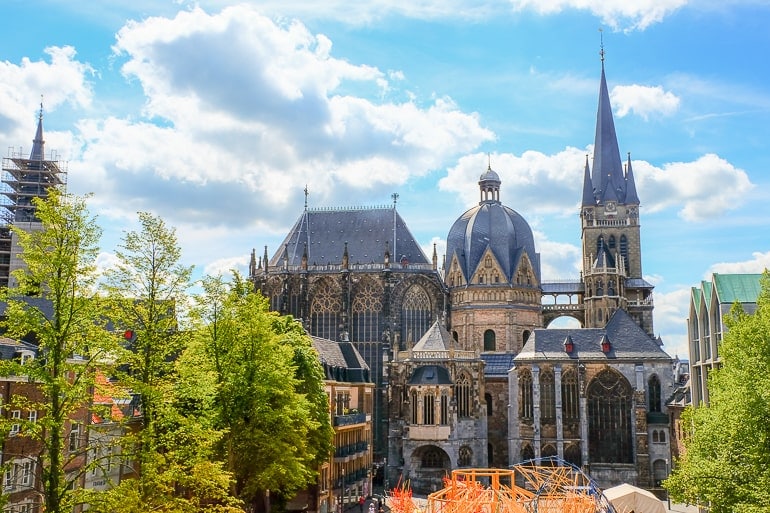
On the second day of this Germany itinerary, you have a few different option: you can either spend another day in Cologne if you feel like you haven’t seen enough of the city yet or take a day trip to Monschau or Aachen. Both of these are two places not too far from Cologne.
Monschau is a popular day trip in the area mainly because of its picturesque buildings in the old town. In fact, you probably have already seen photos of it on social media. To get to Monschau from Cologne, you can either drive or take a combination of trains and buses.
Getting to Monschau takes around 1 hr 40 minutes by car and approx. 2 hours by public transport. To visit Monschau by public transport, you can take the regional train from Cologne to Aachen-Rothe Erde and then take Bus #66 from there to Monschau.
Must-see Attractions in Monschau:
- Monschau Castle
- Old Town
If you want to go on a day trip but don’t want to venture that far, then Aachen would be another great option. This city is actually Germany’s most western city very close to the borders of The Netherlands and Belgium.
We’ve lived close to Aachen for a while and have written a whole guide full of things to do in Aachen that you should read if you want more information. In our opinion, one day is the perfect amount of time to explore the city since it doesn’t have that many attractions and the old town in the city centre is quite compact (but still very pretty).
Getting from Cologne to Aachen is also very easy. It takes approx. 1 hr 20 minutes by car and just around 50 minutes by regional train. You should look into getting a “Schönes Tag Ticket NRW” for the day if you’re travelling with more people as this can save you some money.
Must-see Attractions in Aachen:
- Aachen Cathedral
- Town Hall
- Elisenbrunnen
Day 3: Koblenz
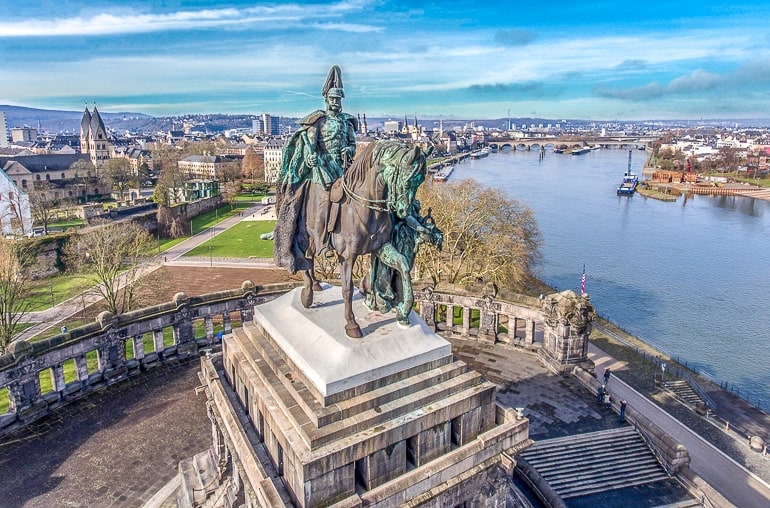
From Cologne, your journey continues to Koblenz – another city on the Rhine River. Koblenz is a smaller German city with a population of slightly over 110,000 inhabitants.
There are quite a few castles and nice hikes in the area which are easy to reach from Koblenz – just in case you decide that you don’t want to spend the day in the city. Depending on the time of year, you could also look into booking a boat tour on the Rhine river. This way, you get a unique perspective of the beautiful region.
Getting from Cologne to Koblenz is pretty easy and will take approximately 1 hour 30 minutes by car and between 50 minutes and 1 hr 10 minutes by train. We really like this train journey since the tracks follow the river for a majority of the trip. As a result, you get some really nice views – and might even spot some of the beautiful castles in the area!
Accommodation in Koblenz: Koblenz is certainly not a huge city – but you’ll still find a good number of places to stay for a night or two. You can check here for accommodations and hotels in Koblenz.
For a hotel right in the city centre, check out the Sander Hotel. This lovely hotel is super popular and close to shops and the rivers. If you are arriving to Koblenz by car, there is onsite parking at the hotel. However, since the city is smaller you can also easily reach the hotel by walking from the central train station.
Must-see Attractions in Koblenz:
- Deutsches Eck
- Ehrenbreitstein Fortress
- Koblenz Cable Car
Day 4: Frankfurt
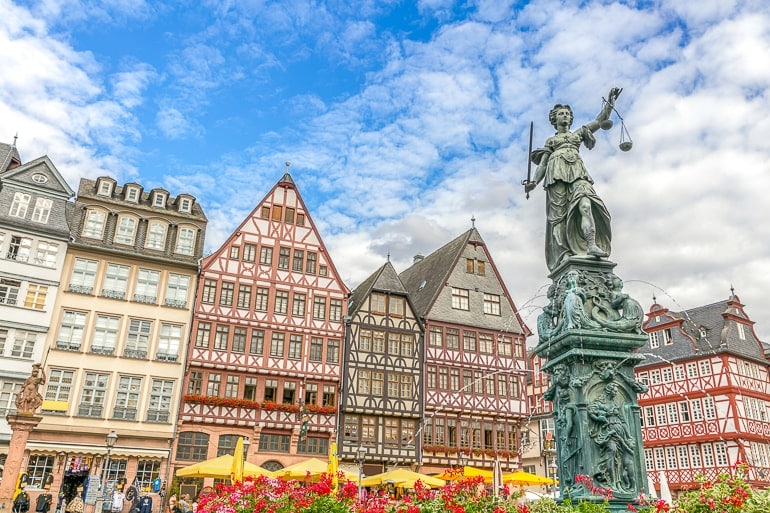
The next stop on your itinerary is Frankfurt, arguably one of the country’s most popular transport hubs due to the busy Frankfurt airport. Frankfurt is an interesting city that divided people: some people really enjoy it while other people don’t like it at all. To be fair, we haven’t spent enough time in the city to really solidify our opinion.
Either way, we do believe that Frankfurt is a stop that you shouldn’t miss if you are trying to get to know different areas of Germany. Known as the financial hub of Germany, this city with its many skyscrapers can feel quite a bit more modern than other German cities. However, the city also has a beautiful, historical market square that you should visit.
The journey from Koblenz to Frankfurt is another easy one – and if you are taking the train (we would recommend that!), you’ll once again follow the Rhine River for big parts of the journey and be rewarded with some great views.
The train ride will probably be between 1 hr 25 minutes and 2 hrs 12 minutes long – depending on the connection you choose. By car, the trip will take around 1 hr 30 minutes. Of course, this can vary depending on traffic.
Accommodation in Frankfurt: There are loads of places to stay in Frankfurt given its popularity and size. You can check here for accommodations and hotels in Frankfurt.
A great option in Frankfurt is the Motel One Frankfurt-Römer. Located very much in the heart of the city centre close to the old town and river, this cool hotel has underground parking if you are arriving to Frankfurt by/with a car. It also serves up a great breakfast!
If you are arriving by train to Frankfurt, you should check out Fleming’s Express Hotel Frankfurt. Located literally right beside the central station (which is in the city centre), this upscale hotel is very popular because it’s very affordable and also has a great breakfast.
Must-see Attractions in Frankfurt:
- Römerberg
- Main Tower
- Palmengarten
Day 5: Heidelberg
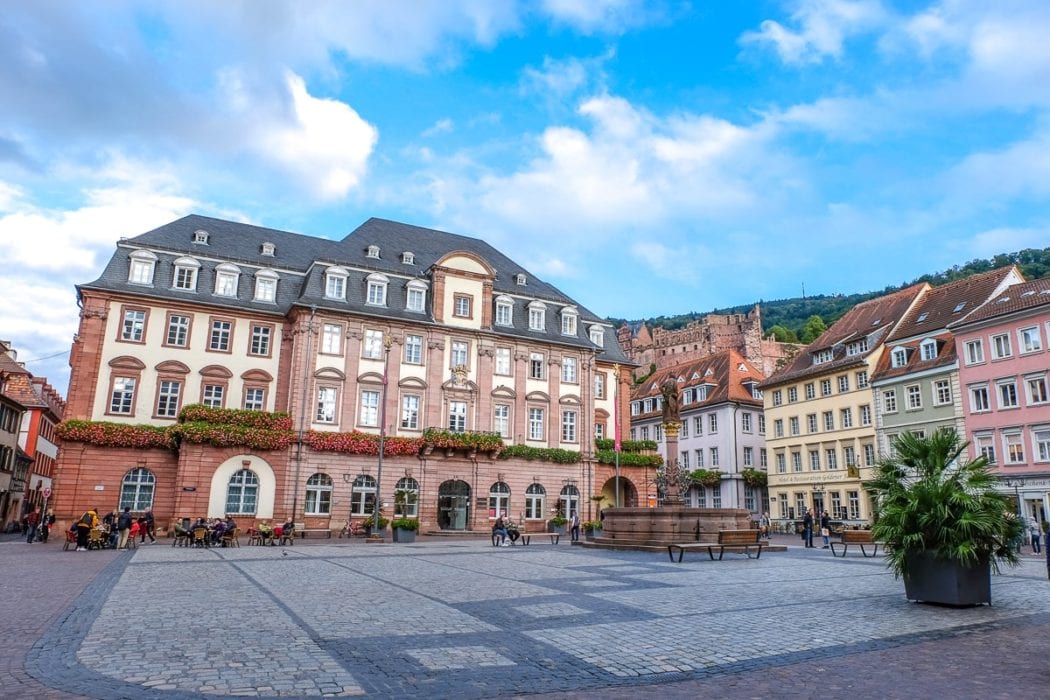
After your day in Frankfurt, you’re heading to Heidelberg which is actually one of our favourite German cities. The highlight of the city is certainly the castle on top of the hill which is visible from many different parts of the city.
Heidelberg is smaller than Frankfurt so you can see quite a bit in just 24 hours. The Old Town is beautiful and lots of attractions are located there. Our highlight was probably the tower climb of the Church of the Holy Spirit. From up there, you get a beautiful view of the Old Town. A very close second was the cable car ride up to the Königstuhl which was lots of fun – even in the rain.
Getting from Frankfurt to Heidelberg won’t take too long. The journey will be approximately one hour by car and between 45 minutes and 1 hr 30 minutes by train – depending on which type of train you are taking.
Accommodation in Heidelberg: If you’re heading for Heidelberg (good choice), there are lots of great places to stay. You can check here for hotels and accommodations in Heidelberg.
We stayed a little outside the old town – but close to the train station – at NinetyNine Heidelberg City. This hotel was really, really great. The beds were comfy and the decor has animals everywhere – you have to see it to understand!
There’s onsite parking (paid) and street parking (free, but not guaranteed) if you are travelling with a car. There’s also a tram stop right outside the hotel to get directly into the city centre in minutes.
If you are looking to stay in the historic old town, then check out colourful hotels like Hotel Holländer Hof which overlooks the river or Hotel Zum Ritter St.Georg which is literally overlooking the main Marktplatz.
Must-see Attractions in Heidelberg:
- Heidelberg Palace
- Church of the Holy Spirit (mainly tower climb)
- Old Bridge
If you want to learn some more about Heidelberg and what there is to do, you can read our detailed Heidelberg Guide here.
Day 6: Stuttgart
The next day you will drive to Stuttgart, a city that we’ve already mentioned in one of our Germany itineraries for 5 days. As we have already mentioned, you’ll probably really enjoy Stuttgart if you are interested in cars.
Even if you aren’t, there is still lots for you to explore. Did you know that wine also plays a huge role in Stuttgart and the surrounding region? If this is something that interests you and you’re there in the summer (specifically around the end of August), then you should stop by the “Stuttgarter Weindorf” (“wine village”) – but obviously, please don’t drink and drive.
As for getting from Heidelberg to Stuttgart, the journey will take you approximately 1 hr 20 minutes by car and between 40 minutes and 1 hr 30 minutes by train. As mentioned before, the time differs depending on the type of train you are choosing.
Accommodation in Stuttgart: Stuttgart has many places to stay so you can check here for accommodations and hotels in Stuttgart.
Be sure to see the Abalon Hotel ideal if you have a car. This hotel has underground parking available and a tasty breakfast. It’s also in the city centre which makes sightseeing easy.
Those coming to Stuttgart by train should look at the Pension am Heusteig. It’s a guesthouse that is located not too far from the first hotel here and it’s a doable walk or metro ride from the central station.
Must-see Attractions in Stuttgart:
- Schlossplatz
- Mercedes-Benz Museum
- Staatsgalerie Stuttgart
Day 7: Stuttgart / Day Trip to Freiburg im Breisgau
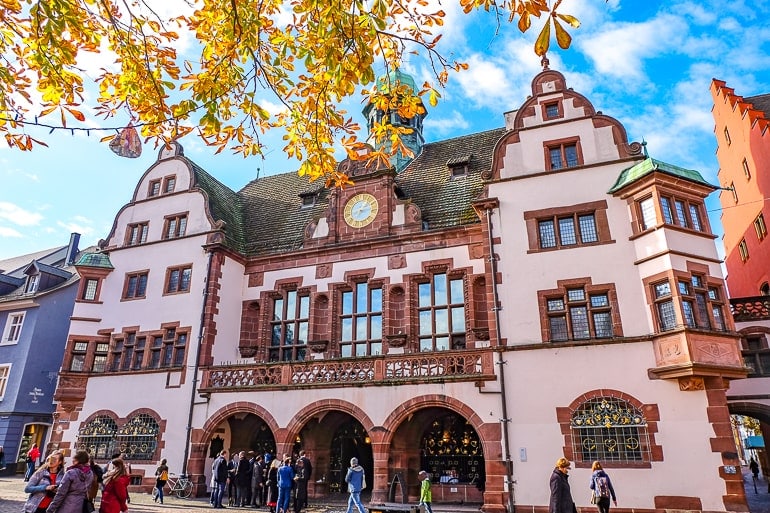
For this itinerary, you can decide how you would like to spend your last day. You could either spend another day to explore more of Stuttgart (and maybe relax for a bit) or you could head farther south and spend a day in Freiburg im Breisgau. We really enjoyed spending time in this small city in the south of Germany during our visit.
We are currently still in the process of writing our Freiburg guide, but we’ll link it here once it’s done. However, a good way to start your exploration of the city is by wandering the old town.
In Freiburg, you’ll find that many of the cobblestoney streets have small water-filled runnels – called Bächle – running alongside it. Sometimes they even have small yellow ducks in them!
The journey from Stuttgart to Freiburg im Breisgau is slightly longer than most other parts of this itinerary. It takes approximately 2 hrs 30 minutes by car and around 2 hours by train. Since this train journey will probably include at least one ICE (the fast train), we’d recommend that you book your train tickets early if you can to save some money.
Must-see Attractions in Freiburg:
- Freiburger Münster (Cathedral)
- Schlossberg + Tower
- New + Old Town Hall
Germany Travel Itinerary 7 Days – East
If the other week-long Germany itinerary doesn’t interest you and/or you really want to visit the German capital Berlin, then you might prefer this eastern route instead.
The driving time would be just slightly over 10 hours and would be approximately 900 km driving distance – including the day trip to Potsdam (which would honestly be easier with public transport, though)!
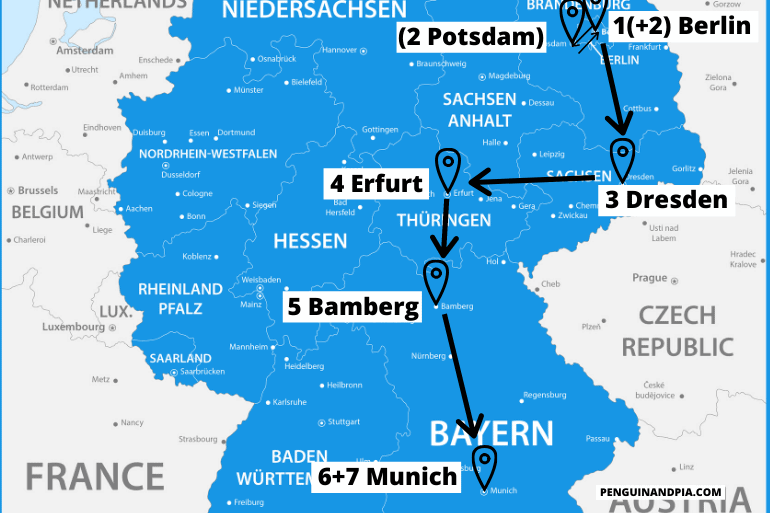
Day 1: Berlin
Day 2: Berlin / Day Trip to Potsdam
Day 3: Dresden
Day 4: Erfurt
Day 5: Bamberg
Day 6+7: Munich
Day 1: Berlin
Once again, this itinerary begins in Berlin since it is one of the big cities that is easier to get to for people coming from overseas. Similar to the five day itinerary that started in Berlin, you’ll stay two nights in the German capital. There is just too much to see to spend only one day – and even in two days you wouldn’t be able to explore everything.
In case you’ve already been to Berlin on a different trip and/or aren’t a huge fan of big cities, we also give you the option of a day trip to Potsdam (a city close by) on the second day. More on that below.
— Compare prices from rental car companies in Berlin here
Accommodation in Berlin: Finding a place to stay in Berlin can be tough because there are just so many options. You can check here for accommodations and hotels in Berlin.
If you have a car, check out Park Plaza Wallstreet Berlin Mitte. Located right in the middle of the city close to Museum Island, this hotel has a great breakfast and free parking on the street behind the hotel. Otherwise, parking is paid but for a decent price for the city centre.
Those without a car travelling by train should see the NH Collection Berlin Mitte am Checkpoint Charlie. If you want a hotel close to a top attraction that is easy to get to with public transport, this is definitely one of them!
Across the city, PLUS Berlin is a really good hostel/hotel that Eric stayed at a few years ago. It’s a big place but it was a great stay over by the East Side Gallery (part of the Berlin Wall with the graffiti on it).
Must-see Attractions in Berlin:
- Brandenburg Gate
- Reichstag
- East Side Gallery (Berlin Wall)
As already mentioned above, if you want to read some more about Berlin, check out our articles on Things to do in Berlin and How to spend one day in Berlin.
Day 2: Berlin / Day Trip to Potsdam
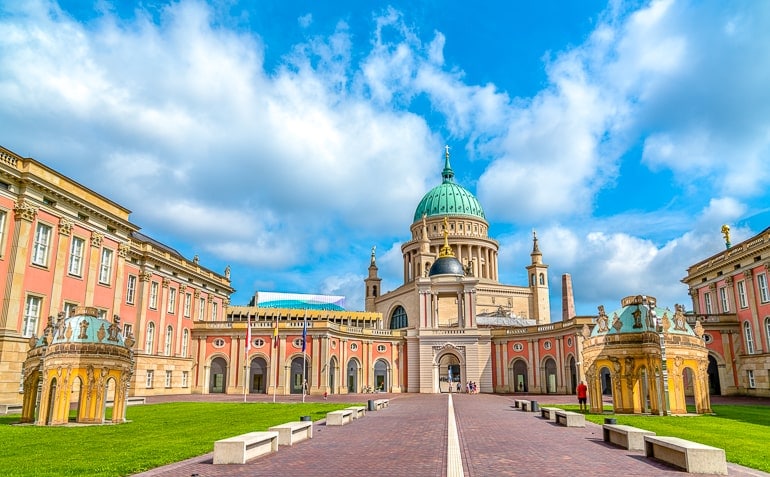
On your second day, you can choose between spending another day in Berlin to see more of the German capital or going on a day trip to Potsdam – which is a smaller city not far from Berlin.
Potsdam is actually the capital city of the German state called Brandenburg. It’s most popular attraction is probably Sanssouci Palace with the beautiful Sanssouci Park surrounding it.
During our visit, we also enjoyed walking through the Dutch Quarter with its small shops and cafes. Since the city isn’t too big, one day gives you a chance to get a good impression and check out some of the more popular sights.
It is also very easy to get to Potsdam from Berlin. If you decide to drive, it’ll take you approx. 40 minutes, but it could be longer – traffic depending. We would honestly recommend that you do this day trip by taking public transport. This way, you don’t have to worry about traffic and/or finding a parking spot.
For trains, you can take the S-Train #7 (S7) from Berlin Central Station (as well as other train stations) straight to Potsdam Central Station. The journey will take around 35 minutes with trains running very frequently throughout the day.
Must-see Attractions in Potsdam:
- Sanssouci Palace
- Dutch Quarter
- Cecilienhof
Day 3: Dresden
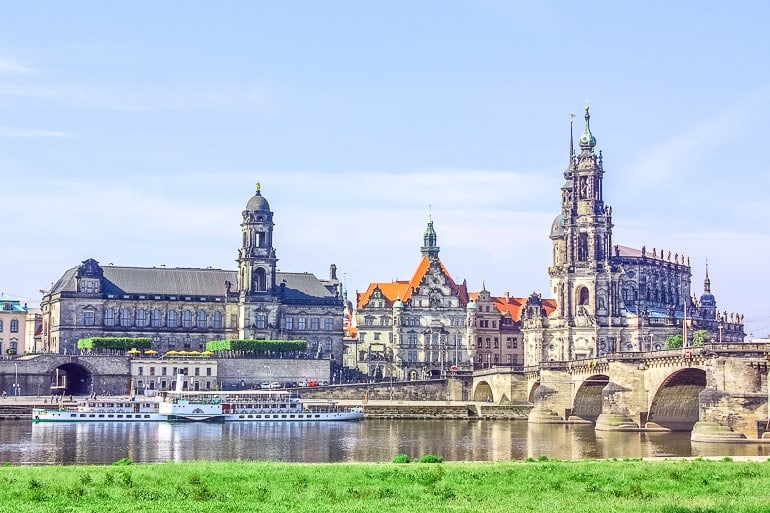
The third day of this Germany itinerary will take you from Berlin to Dresden which is a German city close to the Czech border. To be honest, we haven’t spend that much time in Dresden yet – and it’s certainly on our list of places to visit this year.
One of the city’s main attractions – the Zwinger – is known across the country and a sight that you shouldn’t miss during your visit. It’s a beautiful palace built in a baroque style.
Fun fact: When Lisa was a kid, she didn’t actually know that the “Zwinger” was a palace. Since that word can also mean “dog kennel” in German, she was always confused as to why people would want to visit it during their time in Dresden!
As for getting from Berlin to Dresden, the drive will take you around 2 hrs 10 minutes by car and around 2 – 3 hours by train. Once again, this depends on which connection you choose.
Accommodation in Dresden: There are a number of accommodations in the compact “Innere Altstadt” close to the River Elbe for you to choose from. You can check here for accommodations and hotels in Dresden.
For a great hotel option right in the old town, look no further than the Star Inn Hotel Premium Dresden im Haus Altmarkt. You’re a short walk to the train station, the river, and all the best old sights in Dresden if you stay here and arrive by train. If you come to Dresden by car, the hotel has discounted underground parking available.
Another option right in the old town (and even closer to the river) is Aparthotel am Schloss. Since this is an apartment-style hotel, it’s a great option if you are looking for more of a base to relax in a “home away from home”. It’s a very popular choice, too – and also has onsite parking.
Must-see Attractions in Dresden:
- Zwinger
- Frauenkirche
- Semperoper
Day 4: Erfurt
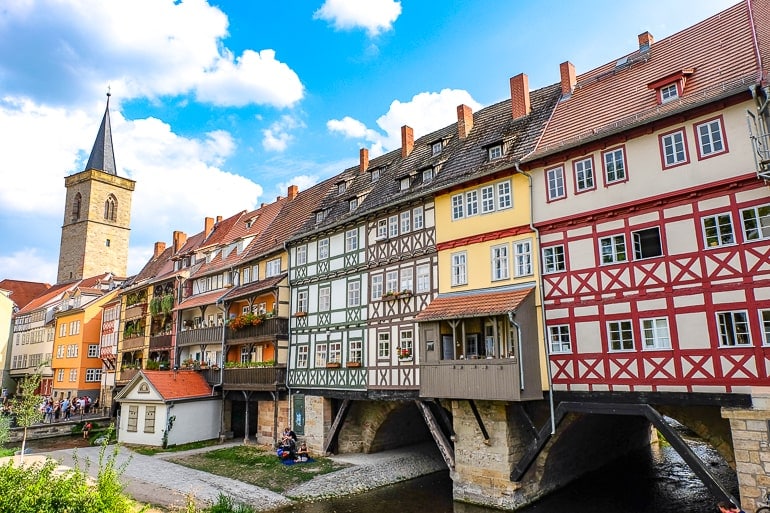
Erfurt is a popular city to visit in the middle of Germany – and it’s also the capital city of the German state Thuringia. We’ve spent some time in Erfurt a few months ago and instantly fell in love with the city. Its size is perfect (in our opinion) – giving you enough things to do without feeling overwhelming.
Maybe you’ve seen photos of one of the city’s most popular attractions, the Krämerbrücke. This bridge is not only pretty to look at and photograph, it’s also unique in the sense that there are buildings on the bridge and when you’re walking on it, you can’t actually see the water running below.
Visiting the bridge and climbing the tower of the Ägidienkirche, a church at one end of the bridge, is something we’d certainly recommend during your time in the city. We actually filmed a short video of our time exploring Erfurt. If you are interested in seeing what parts of the city look like, then you can find our video here.
Getting to Erfurt from Dresden won’t take you too long. It will take approx. 2 hours 20 minutes by car and between 2 and slightly over 3 hours by train.
Accommodation in Erfurt: Since Erfurt isn’t a huge city, there aren’t a ton of accommodations – but certainly more than enough to find one that works for your style and budget. You can check here for hotels and accommodations in Erfurt.
We stayed at Gästehaus in der Gotthardtstraße and really liked our stay. It’s located in a quiet neighbourhood just north of the city centre – a short walk to the Krämerbrücke. The host was lovely, the room was cozy, and there was secure onsite parking for those driving to Erfurt.
If you want to stay RIGHT in the city centre then you should check out Hotel Krämerbrücke Erfurt which is right beside the famous bridge. This might be a good place to stay if you are travelling to Erfurt by train and you’re on-foot.
Must-see Attractions in Erfurt:
- Krämerbrücke
- Erfurt Cathedral
- Citadel Petersberg
For more details, have a look at our Things to do in Erfurt article.
Day 5: Bamberg
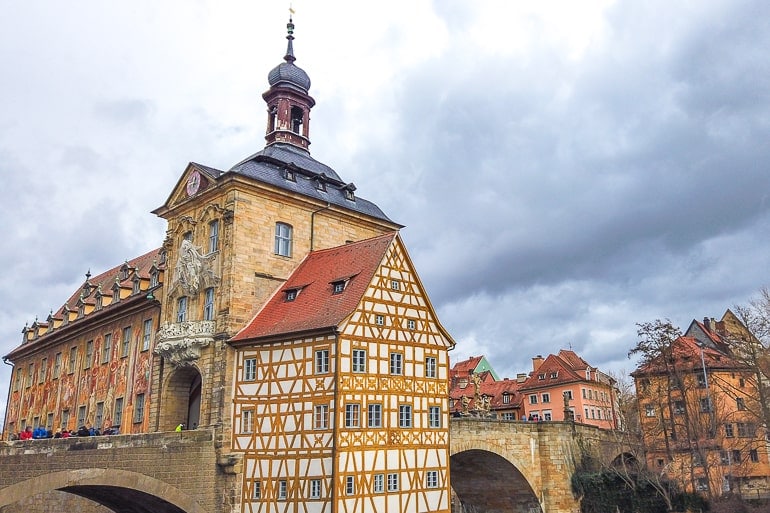
Bamberg is a small city – or larger town – in the German state called Bavaria. It’s actually located in a region called Franconia, which is noticeably different from the Bavaria that you might know in the area surrounding Munich, etc.
We’ve been to Bamberg multiple times over the years (it’s also close to the part of Germany where Lisa grew up) and are always happy to come back. Bamberg is known for its cute, historic old town which is actually a declared UNESCO World Heritage Site.
One of the most popular buildings the city has to offer is the Old Town Hall (shown above) which is built on an artificial island. The story behind it is quite interesting.
The drive from Erfurt to Bamberg is doable and will take approx. 2 hrs by car and around 3 hrs by train. On the way, you’ll drive through quite a few tunnels since you’ll drive through an area known as “Thuringian Forest”.
Accommodation in Bamberg: Bamberg is a small place to visit so there aren’t a ton of options but still enough to find what you’re looking for. You can check here for accommodations and hotels in Bamberg.
Anywhere you stay is basically in or close to the old town/city centre. For a place to stay with parking (for those arriving by car), check out Welcome Hotel Residenzschloss Bamberg. It’s located right on the river.
You might also want to see Palais Schrottenberg to stay right in the middle of the Old Town! For reference, the train station is a short walk to the north of the river – not far from these places in the centre.
Must-see Attractions in Bamberg:
- Bamberg Cathedral
- Old Town Hall
- Alte Hofhaltung
If you want some more information about Bamberg, please read our detailed Bamberg, Germany Guide.
Day 6+7: Munich
From Bamberg, your journey will continue to Munich which will be the last stop on this 7 day eastern itinerary. Not only is this the third biggest city of the country, it is also one of the most internationally known destinations in Germany.
Whenever we come back to Munich, we always enjoy our time there. For some reason, the atmosphere always feels more laid back than in other big German cities and the people are usually quite friendly. We might also be a little bit biased, though, since Lisa grew up in this part of the country and is more used to the mentality, dialect etc. than in other parts of Germany.
For this itinerary, you’ll spend two days in Munich since there is quite a lot to see. Next to the obvious attractions like the Marienplatz with the New Town Hall and the Frauenkirche close by, there are also lots of museums and other things that you can explore.
If you’ve already been to Munich before and/or decide that one day in the city is enough for you, you could also opt for a day trip on one of these days. We’ve just recently written a whole Day Trips from Munich Guide, which you can browse through to get some inspiration!
Driving from Bamberg to Munich will take about 2 hrs 20 minutes by car and between 2 and 3 hrs by train. If you decide to only take regional trains instead of the ICE (fast train), you should look into getting the Bayernticket. This can save you some money, especially when you’re travelling with more people.
Accommodation in Munich: Since Munich is so large and popular to visit, there is definitely no shortage of places to stay! You can check here for accommodations and hotels in Munich.
That said, we loved our stay at H2 Hotel München Olympiapark. Located up by the famous Olympic Park, we’d highly recommend it since it was amazing value for money. The breakfast was huge and delicious and there’s a metro station outside the lobby door that takes you into the heart of the old town in minutes. There’s also parking if you are arriving by car.
For a hotel that is a little more central, you should see the Platzl Hotel Superior this hotel is really popular – and for good reason. It’s located around the corner from attractions like Marienplatz and the famous beer hall, Hofbräuhaus.
For more help looking into accommodations and neighbourhoods in Munich, check out our where to stay in Munich guide.
Must-see Attractions in Munich:
- Marienplatz with New Town Hall
- Olympic Park
- Victuals Market
- English Garden
(Check out our guide to one day in Munich if you want more details on things to do and see.)
Germany Itinerary 10 Days
Although we have tried to create short itineraries that allow you to see more than just the standard cities, it is no doubt easier to see more of Germany if you are able to travel for longer than one week. To give you a couple different options that you could look at (and then potentially modify), we have created two 10-day Germany itineraries.
Once again, we believe that ten days would not be enough time to see the whole country – and even if you managed to do that it would be too stressful (in our opinion). Both of the following itineraries give you a good mix of bigger and smaller cities as well as a few interesting day trips. So, have a look and see which one you like better!
Germany Itinerary 10 Days – North
If you’re interested in seeing more of the northern part of Germany and experiencing the mentality and way of life of people in the flatter part of the country, closer to the sea, then have a look at the following 10-day itinerary!
The total driving time would be slightly less than 17 hours with a distance of approx. 1470 kilometres. For these calculations, we have included the day trips to Schloss Drachenburg, Lübeck, and Flensburg. So, if you decide to skip any of these, your driving time and distance would obviously be slightly lower.
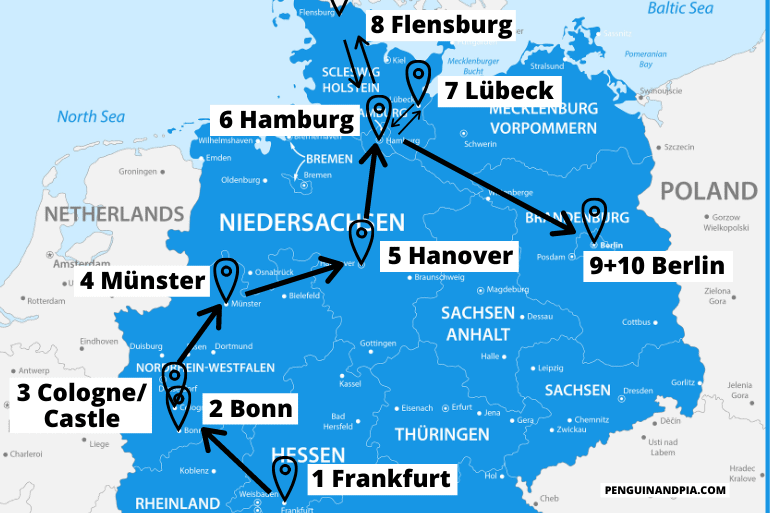
Day 1: Frankfurt
Day 2: Bonn
Day 3: Day Trip to Schloss Drachenburg / Cologne
Day 4: Münster
Day 5: Hanover
Day 6: Hamburg
Day 7: Day Trip to Lübeck
Day 8: Day Trip to Flensburg
Day 9+10: Berlin
Day 1: Frankfurt
Similar to some of the other itineraries mentioned in this article, we start this 10-day itinerary in Frankfurt. By now you should probably already know why – Frankfurt has the biggest airport of the country which should make it easier for people coming from overseas to get to Germany and start their adventure.
Furthermore, Frankfurt is quite centrally located so it is easy to get to many different cities from here. So even if you decide against following our itineraries step-by-step, Frankfurt would be a good starting point!
— Compare prices from rental car companies in Frankfurt here
Accommodation in Frankfurt: You’ll find plenty of places to stay in Frankfurt. You can check here for accommodations and hotels in Frankfurt.
One really popular hotel in Frankfurt is the Motel One Frankfurt-Römer. This Motel One is near the river and walking distance to lots of things in the city centre. If you are coming to Frankfurt with a car, Motel One has underground parking which can make life easy! They also have a nice breakfast.
A hotel option closer to the train station is Fleming’s Express Hotel Frankfurt. This hotel is just to the north of the main station which makes it a great option if you are arriving by train and have no car. It’s popular because it has a great breakfast and is good value for money.
Must-see Attractions in Frankfurt:
- Römerberg
- Main Tower
- Palmengarten
Day 2: Bonn
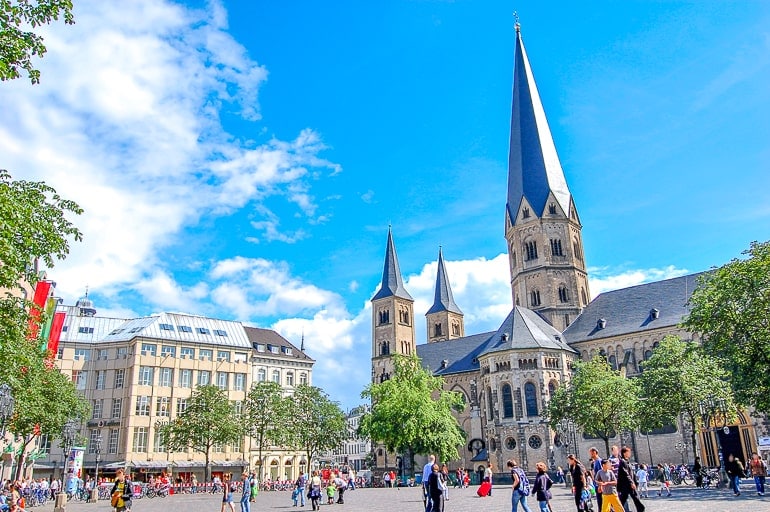
On the second day, you’ll head from Frankfurt to Bonn. As you might know, Bonn used to be the capital of the Federal Republic of Germany during the time that Germany was split into two countries. Later, the capital was relocated from Bonn to Berlin.
If you are interested in learning more about the history of Germany during your time in the country, then Bonn would be a good city to do that in. For example, you could visit the so-called “Haus der Geschichte” which is a museum about the history of the Federal Republic of Germany.
It won’t be difficult to get from Frankfurt to Bonn since the two cities are not too far apart. The journey will take approximately 1 hr 50 minutes by car and between 1 hr 20 minutes and 2 hrs if you take the train. Once again, we’d recommend that you book your train ticket in advance if possible.
Accommodation in Bonn: There are a number of accommodation options in Bonn which you can choose from – many are right in the city centre/old town. You can check here for accommodations and hotels in Bonn.
Keep in mind to book your accommodation for two nights for this itinerary. (You could also spend the following night in Cologne if you day tripped to there, though).
For a great hotel in the heart of the old town, check out BrauHotel Bonn. You can easily walk here from the central train station but they also have a and parking garage close by if you arrive by car. There’s also a craft beer bar on the ground floor!
Another option is the Hilton Bonn. This hotel offers you amazing views of the Rhine River. It’s a bit north of the city centre but still very much close to it. There is parking but it can be expensive so keep that in mind when you book.
Must-see Attractions in Bonn:
- Bonn Minster
- Old Town Hall
- House of the History of the Federal Republic of Germany (Haus der Geschichte)
Day 3: Day Trip to Schloss Drachenburg / Cologne
On day three of this itinerary, you can choose to stay in Bonn, or go on one of two day trips: to Schloss Drachenburg (a castle not far from Bonn) or to Cologne which is also close by.
Schloss Drachenburg is actually a private villa/mansion that was built to look like a castle in the 19th century. Today, it is a popular attraction in the area.
From Bonn, you can either drive to Königswinter by car (and then leave your car at the car park) or take public transport to the Königswinter/Clemens-August-Straße station. You can find more information about that and opening hours etc. on the offical website.
If you are not a huge fan of castles, then you might opt for a day trip to Cologne instead. In this case, you might even decide to change your base and spend the night in Cologne instead of returning to Bonn at the end of the day. That is definitely an option that you can choose since there are lots of accommodation options in Cologne as well.
Getting to Cologne from Bonn will take you around 40 minutes by car (this can obviously depend on traffic) and only approx. 25 minutes by train. Just a quick warning: Trains can get very full if you are travelling during rush hour traffic – so try to avoid that if you don’t like being surrounded by lots of people in a small space.
Must-see Attractions in Cologne:
- Cologne Cathedral
- Old Town
- Cologne Chocolate Museum
Day 4: Münster
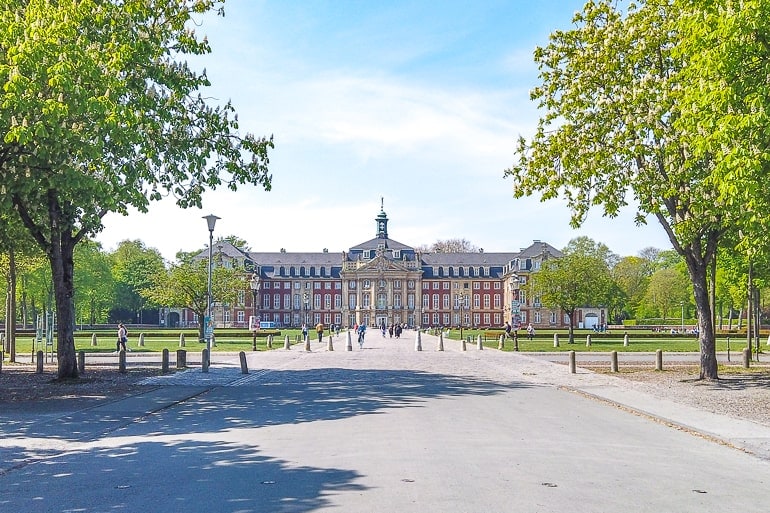
The next day you’ll head from Bonn – or Cologne – to Münster. Since Bonn and Cologne are so close, the journey wouldn’t really differ much from either city.
Münster is a smaller German city that we really enjoy. To be honest, it sometimes reminds Lisa of Copenhagen – mainly because of the many bikes that you can see all around the city. The University of Münster plays a big role in the city and the vibe – depending on which part of the city you are in – is noticeably younger.
One of the highlights of the city – for locals and visitors alike – is the lake Aasee which is located quite centrally. When the weather is nice, there are always people sitting on the grass enjoying the sun and maybe even out on the water (depending on the time of year). You can rent a small paddle boat to explore the lake from a unique perspective.
The journey from Bonn to Münster should take you slightly less than 2 hrs by car and between 2 hrs and slightly more than 3 hrs by train. If you want to save some money and are travelling with other people, then you should look into getting an “NRW Schönes Tag Ticket”. With this ticket, you wouldn’t be allowed to travel on ICE’s (the fast train), but the connections using only regional trains wouldn’t be much longer.
Accommodation in Münster: Münster might feel small but it’s actually pretty spread out and offers accommodations for all styles and budgets. You can check here for accommodations and hotels in Münster.
If you want a popular hotel option right in the centre, the H4 Hotel Münster is a short walk to the heart of the historic centre. It also has onsite parking for those travelling to Münster by car – but you can easily walk there from the train station in the south of the city centre.
Must-see Attractions in Münster:
- Münster Prinzipalmarkt
- Historic Town Hall
- Münster Cathedral
For a more detailed guide, have a look at our Things to do in Münster, Germany article.
Day 5: Hanover
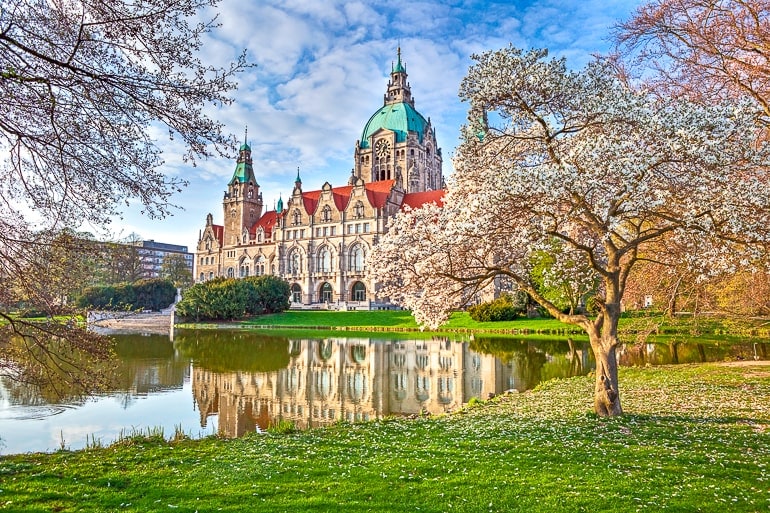
The following day you are travelling from Münster to Hanover. In German “Hannover” is actually written with two “n”, so don’t be surprised if you see it being written slightly differently.
Hanover is the biggest city and the capital of the German state called Lower Saxony. Compared to some other cities on this itinerary it is a less popular tourist destination. To be fair, even we haven’t spent that much time in Hanover yet. Hopefully we’ll be able to change that soon. However, that’s not to say that Hanover is not worth a visit.
Not only can you explore some beautiful gardens and interesting museums in the city, but it is also located pretty much halfway between Münster and Hamburg. That makes it a great stop to break up the journey and spent another day in a city that allows you to explore without too many other (international) tourists around.
By car, the journey from Münster to Hanover will take you around 2 hrs. If you choose to travel by train instead, it will take you approximately the same amount of time.
Accommodation in Hanover: Hanover is a larger city but the accommodation are still relatively packed together in and around the historic city centre. You can check here for accommodations and hotels in Hanover.
For a stay right in the city centre, check out the Hotel Loccumer Hof. This popular hotel is a very short walk from the central station which is perfect if you are arriving to Hanover by train. That said, they also have parking onsite so this hotel works well if you arrive by car!
For another hotel option, check out the Arthotel ANA Prestige am neuen Rathaus. This boutique hotel is directly across from the beautiful New Town Hall in the south end of the city centre by the greenspace and water! They also have a really nice breakfast and parking available.
Must-see Attractions in Hanover:
- New Town Hall
- Marktkirche
- Herrenhausen Gardens
- Maschsee
Day 6: Hamburg
On day six of this 10-day itinerary you’re on your way to Hamburg. If you’ve read the details of any of the shorter itineraries in this article, you’ll know that we really like Hamburg.
The city offers modern areas, such as “HafenCity”, mixed with historic (e.g. “Speicherstadt”) and alternative areas (“Sternschanze”) . This makes exploring the city all the more interesting – there is truly something for everyone. During your time in the city, we’d also recommend that you climb the tower of the St. Michael’s Church. From up there, you get a beautiful view of most parts of the city.
The journey from Hanover to Hamburg won’t be long. Depending on the route you are taking (Highway A7 or A1), it’ll take between 1 hr 30 minutes and 2 hrs by car. If you opt for the train, you can expect the journey to take between 1 hr 15 minutes and 1 hr 30 minutes. This depends on the connection you choose.
Accommodation in Hamburg: Hamburg has many, many places to stay. You can check here for accommodations and hotels in Hamburg.
The Mövenpick Hotel Hamburg might be a good option if you have a car while you travel around Germany. This cool hotel is inside an old water tower which gives guests stunning views of the city around. There’s also parking onsite and it’s close to a transit stop for getting around the city.
Located not too far from the central train station, ARCOTEL Rubin Hamburg makes for a good hotel option if you don’t have a car. It’s located in St. Georg which is a lively area within walking distance of the city centre.
Those that need hostel for their stay in Hamburg might be happy with Generator Hamburg. It’s a popular hostel in the city and is close to the train station for easy getting around. If you’re unsure about where to stay, you can always check out our detailed guide on where to stay in Hamburg.
Must-see Attractions in Hamburg:
- Town Hall
- Speicherstadt
- Elbphilharmonie
- St. Pauli Piers
Once again, if you’d like to read our (very) short Hamburg guide, you can find our Things to do in Hamburg article here.
Day 7: Day Trip to Lübeck
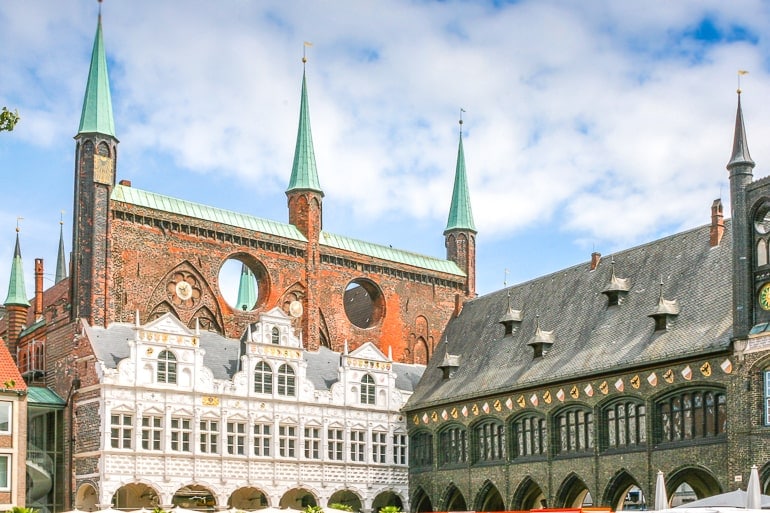
For the next couple of days, we decided to include some day trips from Hamburg. This allows you to stay in one accommodation for longer than just one night and gives you the option to see some more of Hamburg as well. If you don’t want to visit any other cities and want to spend more time in Hamburg instead, then feel free to skip one or both of the day trips mentioned.
Lübeck is the closer one of the two day trips mentioned from Hamburg. Within Germany the city is mainly known for its delicious “Lübecker Marzipan” (Lübeck Marzipan) – but of course there is much more to the city than just that. One of the highlights is the Holsentor, a red-brick city gate dating back to the 15th century.
The journey from Hamburg to Lübeck will take you slightly over 1 hr by car and just around 45 minutes by train. In our opinion, that’s great for a day trip since it gives you lots of time to actually see the city instead of spending a lot of time in the car/on the train.
Must-see Attractions in Lübeck:
- Holstentor
- Marienkirche
- Heilig-Geist-Hospital
Day 8: Day Trip to Flensburg
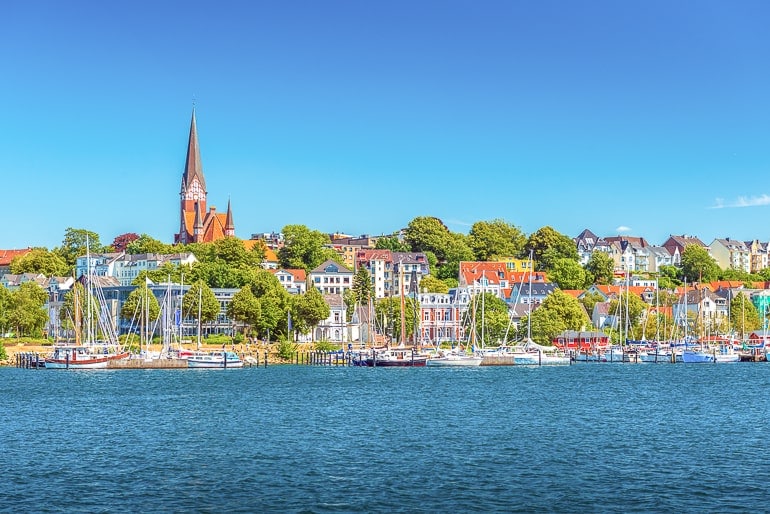
For the following day, we have another day trip option for you. The journey to Flensburg is slightly longer than to Lübeck – but it would be worth it. Flensburg is a smaller German city in the north of Germany, very close to the Danish border.
Since it is located close to the water, shipping plays an important role in the city to this day. If you’re interested in learning more about that, then the Maritime Museum would be a good place for you to visit.
Another thing we would recommend is a walk along the Rote Straße. Here you’ll find different “Hinterhöfe” (similar to backyards) with cute cafes and small shops.
Getting to Flensburg from Hamburg should take slightly less than 2 hrs by car and the same amount of time by train. As already mentioned, it would be a longer journey than to Lübeck, but if you want to experience a smaller, maritime city, the trip would be worth it!
Must-see Attractions in Flensburg:
- Historischer Hafen (Historic Harbour)
- Flensburger Schifffahrtmuseum (Maritime museum)
- Museumsberg Flensburg
Day 9+10: Berlin
On the second to last day of this itinerary, you’ll head from Hamburg to Berlin where your journey ends. This allows you to spend two days in the German capital. Since there is so much to do in Berlin, we’d recommend that you do some research beforehand to narrow down which attractions you’d like to visit.
If you’ve never been to Berlin before classics like the Brandeburg Gate and the Reichstag would be a good place to start. We’ve written a few different articles about Berlin – one about classic attractions (link below). Maybe these will be a good starting point to gather some more information!
The drive from Hamburg to Berlin will be one of the longest mentioned as part of this itinerary – so you should keep that in mind. It’ll take approximately 3 hrs 20 minutes by car (with traffic it could be longer), but just 1 hr 50 minutes by train.
It’s a popular train route since it connects the two biggest German cities so trains run frequently throughout the day. Once again, we’d recommend to book your train ticket in advance to get one of the discount tickets and save some money.
Accommodation in Berlin: As the capital city, there are lots of accommodation options for Berlin. You can check here for accommodations and hotels in Berlin.
Those travelling to Berlin with a car should look into the Park Plaza Wallstreet Berlin Mitte for a hotel in the city centre with free street parking available. There’s always paid parking for a reasonable fee if those are full and you’ll be close to top attractions.
The NH Collection Berlin Mitte am Checkpoint Charlie is a popular hotel option for those coming to Berlin by train since it’s close to attractions in the city centre and you can get there very easily with the metro.
Finally, if you need a hostel/hotel, check out PLUS Berlin. This is where Eric stayed a few years back and really enjoyed it. You’ll be close to the East Side Gallery – the part of the Berlin wall with the artwork on it. It’s also easy to get in and out of the city centre from here.
Must-see Attractions in Berlin:
- Brandenburg Gate
- Reichstag
- East Side Gallery (Berlin Wall)
Also feel free to have a look at our guide on Berlin Attractions and tips for a day in Berlin.
Germany Itinerary 10 Days – South
This 10 day Germany itinerary begins and ends in Frankfurt – so it’s pretty much a small loop through the southern part of the country. If you want to be closer to the mountains (for part of the trip at least) instead of the sea, then this itinerary might be better suited for you than the other 10 day version.
For this itinerary, the total driving time would be slightly over 17 hours with a total distance of approx. 1330 kilometres. This includes the day trips to Neuschwanstein Castle, Garmisch-Partenkirchen, and Tübingen. So depending on if/how you modify the itinerary, these estimates could differ.
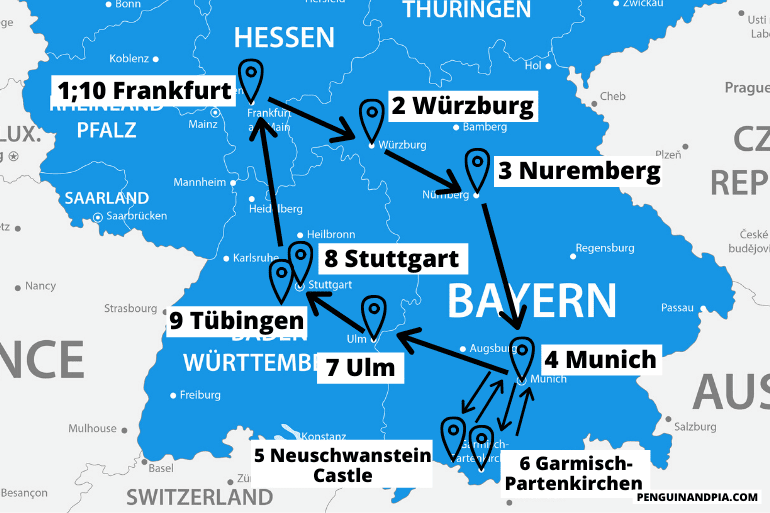
Day 1: Frankfurt
Day 2: Würzburg
Day 3: Nuremberg
Day 4: Munich
Day 5: Day Trip to Neuschwanstein Castle
Day 6: Day Trip to Garmisch-Partenkirchen
Day 7: Ulm
Day 8: Stuttgart
Day 9: Day Trip to Tübingen
Day 10: Frankfurt
Day 1: Frankfurt
Similar to the northern version of this itinerary for 10 days, you begin your adventure in Frankfurt. During your day in the city, you shouldn’t forget to visit the Römerberg with the beautiful half-timbered houses. If you want to get a nice few of the city from above, then you should look into visiting the Main Tower as well.
Frankfurt is also a great place to pick up your rental car – if you decide to complete this itinerary by car instead of using public transport. You can either pick up a car at the airport or at different spots in the city centre. This obviously also depends on the rental company you choose.
— Compare prices from rental car companies in Frankfurt here
Accommodation in Frankfurt: Frankfurt is full of accommodation options – from the city centre to the airport. You can check here for accommodations and hotels in Frankfurt.
For a hotel in the heart of the city, check out the Motel One Frankfurt-Römer. Complete with underground parking, good breakfast, and a top location in the centre and close to the river, this hotel is a decent option if you are travelling around with a car.
For those not travelling with a car (and taking the trains around Germany), check out Fleming’s Express Hotel Frankfurt. This nice looking hotel is really popular for its breakfast, price, and the fact that it’s steps from the central train station.
Must-see Attractions in Frankfurt:
- Römerberg
- Main Tower
- Palmengarten
Day 2: Würzburg
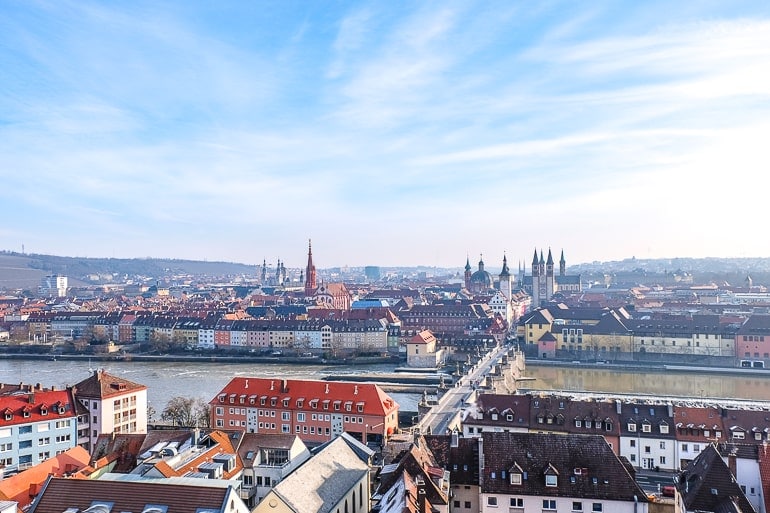
On day two of this itinerary, you’ll be on your way to Würzburg, a small German city that we’re always happy to return to. Similar to Stuttgart, Würzburg is located in a region that is known for its wine.
As such, it comes as no surprise that a highlight in Würzburg is to drink a glass of (white) wine on the Old Bridge across the Main river. We’ve done that multiple times and would especially recommend it during the evening when it gets dark.
Another thing you shouldn’t miss in Würzburg is the short walk up the hill to Marienberg Fortress. Up there you can not only explore the old fortress, but you also get a beautiful view of the old town and other parts of the city.
We actually wrote a whole guide about Würzburg (link below) where we not only talk about things to do but also mention some great cafes and restaurants!
The drive from Frankfurt to Würzburg will be a short one. It should only take you around 1 h 20 minutes by car and between 1 h 07 minutes and 1 hr 50 minutes by train depending on the type of train you’re taking (ICE vs. regional train).
Accommodation in Würzburg: Würzburg isn’t a huge city so you’ll find a number of places to stay packed together in the city centre and a number of other hotels and guesthouses around. You can check here for accommodations and hotels in Würzburg.
On a recent trip, we stayed at the Best Western Hotel Würzburg-Süd. It’s a little south of the city centre but the tram stop is right outside the hotel so you’re into the historic city centre in minutes. There is also an onsite parking lot if you’re arriving to Würzburg by car. We booked this one last minute but we would stay again.
If you want to stay a little more central, then you can check out Hotel Strauss. With a location close to the river, the train station, and the city centre – it’s a great option fo those arriving by train.
We also once stayed at Hostel Babelfish for a budget accommodation and it was honestly not too bad, either. It’s right across from the train station for easy access in and out of the city.
Must-see Attractions in Würzburg:
- Marienberg Fortress
- Old Bridge
- Würzburg Residence
If you want more tips for visiting Würzburg, have a look at our detailed Things to do in Würzburg Guide (+ insider tips).
Day 3: Nuremberg
The next day you’ll be on your way to Nuremberg, which is another city in Bavaria that we really like. In German, Nuremberg is actually written/called “Nürnberg” – just an FYI, so you’re not confused when you see this written somewhere.
As we have already mentioned in the description of one of the shorter itineraries, there is a lot of history to be found in the city. Not only can you explore an old castle in the middle of the city, you can also learn a lot about Germany’s dark history if you’re interested.
Getting from Würzburg to Nuremberg will take approx. 1 hr 20 minutes by car and between 53 minutes (ICE) and 1 hr 13 minutes (regional) by train. If you’re travelling with more people and decide to just take a regional train, look into getting a “Bayernticket” as that could save you some money.
Accommodation in Nuremberg: Nuremberg is a larger and well-travelled city in Germany so you will have no problem finding a place to stay! You can check here for accommodations and hotels in Nuremberg.
We ended up staying in the very popular Five Reasons Hotel and Hostel and we enjoyed our stay. The room was bright with new furnishings. It’s also located just inside the old city walls so we were close to the metro, a short walk to central train station, and also close to the heart of the old town!
Very nearby was the Sheraton Carlton Nuremberg – we had friends stay there. They really liked this hotel which had a swimming pool with city views and other great perks. If you are arriving to Nuremberg by car, there’s a parking lot across the street from the hotel as well as street parking around. The train station is very close as well so it’s a great location overall.
Must-see Attractions in Nuremberg:
- Imperial Castle of Nuremberg (Kaiserburg)
- Documentation Center Nazi Party Rally Grounds
- Albrecht Dürer’s House
Day 4: Munich
On day four of this Germany trip, you’ll be on your way to Munich. As you might know Munich is the capital of the German state called Bavaria and there are lots of things to do in this city.
That’s why you’ll spend three nights in Munich. This way you can explore the city in more detail if you want or go on a couple of day trips from Munich to see other popular attractions as well. It’s really up to you.
The journey from Nuremberg to Munich won’t be overly long and it’s a route Lisa has driven many times. It’ll take you around 2 hrs by car (of course traffic depending) and between 1-3 hrs by train.
Since this is a popular train route, there are lots of different connections of varying length – some are quick and others are slower trains with more stops. Since that’s the case, we’d recommend that you plan in advance and try to catch a better connection to avoid an unnecessarily long train ride!
Accommodation in Munich: Since Munich is such a popular and large city, there are plenty of accommodation options for you to choose from. You can check here for accommodations and hotels in Munich. Just remember to book your accommodation for three nights if you are following this itinerary!
We stayed at the H2 Hotel München Olympiapark which is a very popular hotel because of the price and the value. It was a prefect stay. The breakfast was amazing, they had parking, and the location was great – only a quick metro to the heart of the city centre. You also have the Olympic Park and BMW Museum as top attractions nearby!
If you’re itching to stay right in the heart of the action in Munich, check out the Platzl Hotel Superior. This is a hotel around the corner from Marienplatz in the old town with the famous beer hall Hofbräuhaus just steps away. The central train station is also walkable from here.
Of course, you can learn all about the best areas to stay in more detail with our Munich accommodation and neighbourhood guide.
Must-see Attractions in Munich:
- Marienplatz with New Town Hall
- Olympic Park
- Victuals Market
- English Garden
Learn more about Munich with our one day in Munich post!
Day 5: Day Trip to Neuschwanstein Castle
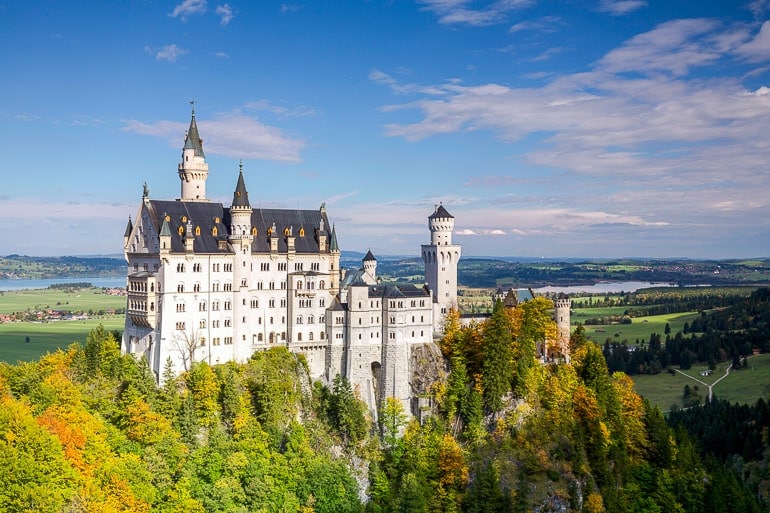
Neuschwanstein Castle probably doesn’t need a lot of introduction – it is arguably one of the most popular day trips from Munich. If you want to see this fairy-tale castle with your own eyes, then this day trip might be for you.
However, it is such a popular attraction that depending on the time of year it can get incredibly crowded. So if you are planning this itinerary for the middle of summer, we’d honestly recommend that you think twice about whether you really want to do this day trip. A second day in Munich wouldn’t be so bad either, would it?
If you are set on visiting Neuschwanstein Castle, then have a look at our Day Trips from Munich Guide. In that article – under the Neuschwanstein Castle section – we talk about all the different ways you can get to the castle.
In case you don’t want to stress too much about logistics and are not travelling with a rental car, you could always look into a day tour that brings you to Neuschwanstein Castle and then back to Munich. Here are some examples:
- Neuschwanstein and Linderhof Palace – A very popular tour to check out two castles in one day!
- Just Neuschwanstein Castle – Grab your live guide and check out the classic castle you came to see!
- Neuschwanstein Castle and Füssen – Explore the surrounding area on this day trip + see that great castle!
Day 6: Day Trip to Garmisch-Partenkirchen
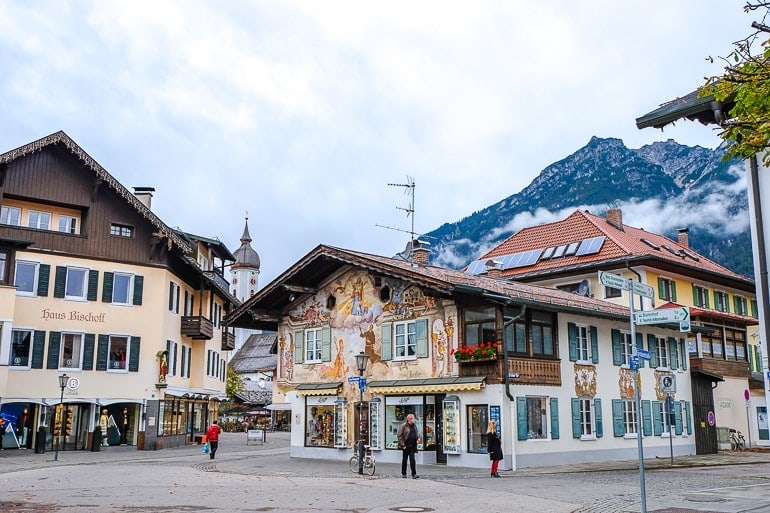
Another popular day trip from Munich – and the one we would recommend for Day 6 of this itinerary – is a trip to Garmisch-Partenkirchen in the south of Bavaria, close to the Austrian border.
We have been to Garmisch-Partenkirchen recently and really enjoyed our day there. However, that was during the shoulder season, so we can’t really say much about how busy it gets in the summer or during the ski-season.
There are a few good reasons for visiting Garmisch-Partenkirchen. The obvious one is that the town is super close to the mountains and it is very easy to reach the “Zugspitze” (Germany’s highest mountain) from here.
Of course, you don’t have to go that high up – there are also lots of other mountains and great hiking trails in the area if you’re looking for a day in nature.
Other reasons why people come to Garmisch-Partenkirchen is to visit the Partnach Gorge which is quite beautiful and/or the old town where you can admire the decorative paintings found on many houses.
It’s actually quite easy to get from Munich to Garmisch-Partenkirchen. By car, it should take you around 1 hr 10 minutes and by train the journey would be approx. 1 hr 22 minutes. It’s actually a nice drive/train ride since you’ll get some great views of the mountains as you get closer to your destination.
Must-see Attractions in/close to Garmisch-Partenkirchen:
- Zugspitze
- Partnach Gorge
- Old Town
Day 7: Ulm
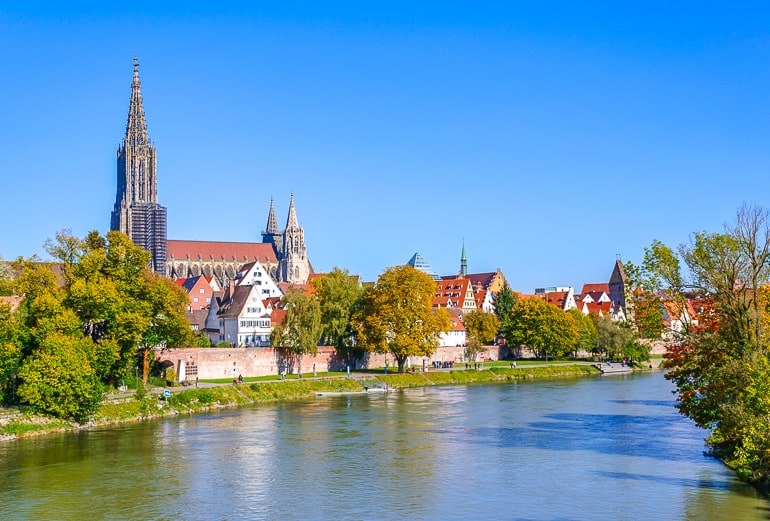
The following day you’ll travel from Munich to Ulm, a small city in the German state of Baden-Württemberg. It is actually located right by the border with Bavaria – “Neu Ulm” in fact is a city on the Bavarian side. When you’re there, it sometimes feels like it is just one bigger city. For you as a visitor, this doesn’t really matter – just an interesting side note.
Ulm is mainly known for having the church with the tallest steeple in the world – so that is something you shouldn’t miss during your visit. Other than that, we’d also recommend that you check out the Fishermen’s Quarter where you can find some beautiful, half-timbered houses.
Getting from Munich to Ulm won’t take you long. The journey will take approx. 1 hr 40 minutes by car and between 1 hr 19 minutes and 2 hrs by train. Once again, this depends on which type of train connection you choose (ICE vs. regional trains).
Accommodation in Ulm: It’s best to stay in the centre of Ulm since it’s not huge and the attractions can mostly be found there. You can check here for accommodations and hotels in Ulm.
For a boutique hotel option right in the city centre, check out Boutique 005 Ulm City. This hotel is super walkable to the train station if you are arriving by train but also offers an option for parking. It’s location makes it really close to all the top attractions in the city.
For a stay closer to the river, you can check out the Hotel am Rathaus – Hotel Reblaus. With onsite parking available and a really good breakfast, this more “authentic” hotel is an experience not to be missed in Ulm.
Must-see Attractions in Ulm:
- Ulmer Münster
- Fishermen’s Quarter
- Town Hall
Day 8: Stuttgart
From Ulm, you’ll head to Stuttgart on the next day. Stuttgart is a city that we have mentioned a few times in this article already. If you’ve read some of the other itineraries, you’ll know that Stuttgart is known for both cars and wine.
Of course, there’s more to see in the city than that. If you’re interested in architecture, you might enjoy visiting the New Palace at the “Schlossplatz” and if you’re into art, the Staatsgalerie (an art museum) might be for you.
Getting to Stuttgart from Ulm will only take slightly over 1 hr by car and approx. the same amount of time by train. There are slower trains – called RB instead of RE which stands for “Regional Express” – that take longer than that. However, if you plan ahead, you shouldn’t have a problem catching an RE or ICE Train since they run frequently throughout the day.
Accommodation in Stuttgart: Since there are a number of places to stay in, you can check here for accommodations and hotels in Stuttgart.
Those with a car can check out the Abalon Hotel ideal because it has an underground parking garage while those travelling to Stuttgart by train can check out the Pension am Heusteig since it’s easy to get to walking or with the metro.
Must-see Attractions in Stuttgart:
- Schlossplatz
- Mercedes-Benz Museum
- Staatsgalerie Stuttgart
Day 9: Day Trip to Tübingen
On day 9 of this itinerary, you have the choice between either spending a second day in Stuttgart or taking a day trip to Tübingen, a university town not far away.
Tübingen is a popular day trip from Stuttgart and is mainly known across the country for its old university. In fact, some of Lisa’s friends have studied there. When in town, you shouldn’t forget to visit the market square with its 15th century town hall. Another popular attractions is the Hohentübingen Castle on the hill which nowadays is home to a museum.
It won’t take you long at all to get to Tübingen from Stuttgart. That makes it great for a (half-)day trip. The journey should only take around 42 minutes by car and between 43 minutes and 1 hr 30 minutes by public transport – depending on the connection you choose.
Must-see Attractions in Tübingen:
- Hohentübingen Castle
- Market Square with Town Hall
- Hölderlinturm
Day 10: Frankfurt
On the last day, you’ll make your way back to Frankfurt. This is where your itinerary ends since it will hopefully be easy for you to get back home from here.
The journey from Stuttgart back to Frankfurt will probably be the longest one for this trip – but it’s still easily doable. It should take you approx. 2 hrs 25 minutes by car and between 1 hr 17 minutes and 3 hrs 30 minutes by train. Once again, this is dependent on the connection you choose (ICE vs. regional trains).
Accommodation in Frankfurt: Since you’re back in Frankfurt, we already went over accommodations in Day 1 of this same itinerary. That said, you can check here for accommodations and hotels in Frankfurt and specifically check out the Motel One Frankfurt-Römer for a central hotel with parking.
Must-see Attractions in Frankfurt:
- Römerberg
- Main Tower
- Palmengarten
Germany Itinerary 14 Days
This Germany itinerary is the longest one that we have for you – for now. If anyone is interested in a 21 day version, please let us know!
The distance you’d cover with this 14 day itinerary would be around 1960 kilometres. The driving time would be approx. 22.5 hours – but of course, this varies depending on traffic and the exact route you decide to take.
As you’ll see below, sometimes the driving time between two cities is longer than 3 hours. So, while this itinerary is totally doable in two weeks – if you wanted to slow down the pace a bit, you could just as easily spend more time in some of the cities and complete the itinerary in more days.
Since you have probably already read about most of these places in some of the itineraries above, we’ll try to keep the descriptions short and not get too repetitive.
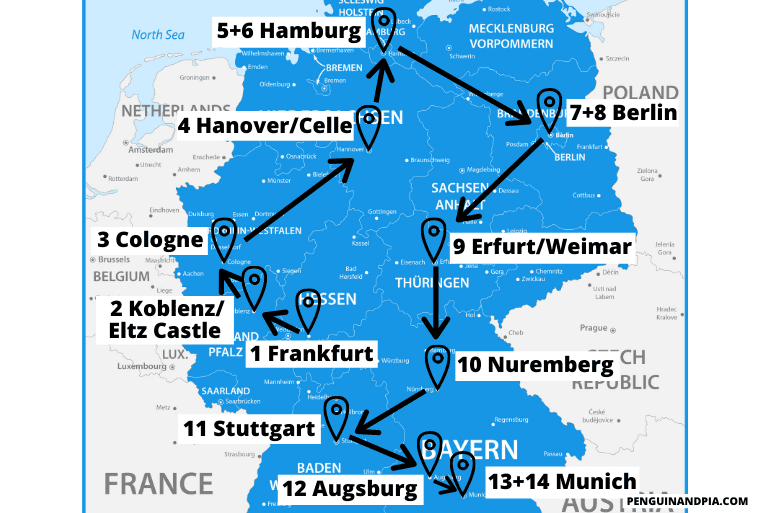
Our version here is written as an “incomplete route” from Frankfurt to Munich. However, as with most of our itineraries, you are welcome to reverse the direction if that works better for you and/or start and end in the same city. So, to see a big part of the country, your 14 day Germany itinerary could look something like this:
Day 1: Frankfurt
Day 2: Koblenz / Eltz Castle
Day 3: Cologne
Day 4: Hanover or Celle
Day 5+6: Hamburg
Day 7+8: Berlin
Day 9: Erfurt or Weimar
Day 10: Nuremberg
Day 11: Stuttgart
Day 12: Augsburg
Day 13+14: Munich
Day 1: Frankfurt
Once again we begin this itinerary in Frankfurt since it is an easy city to get to. As we have mentioned before, there are a few things to see in the city so you can start exploring on day one!
Frankfurt is also a great city to pick up a rental car. Since many international (business) travellers fly into Frankfurt, there should be many cars available with automatic transmissions. In smaller German towns you’ll find that this is not always the case.
— Compare prices from rental car companies in Frankfurt here
Accommodation in Frankfurt: If you are making a stop in Frankfurt, you can check here for accommodations and hotels in Frankfurt.
As for accommodation options, the Motel One Frankfurt-Römer has parking available and is located in the city centre close to the Main River. That’s important if you have a car with you but it’s also walkable to the train station, so you know.
Another great hotel option that is even closer to the train station is Fleming’s Express Hotel Frankfurt. This hotel is known for its prime location to the north of the station, its tasty breakfast, nice decor, and fair price. This is definitely a popular place you should at least look into if you are travelling by train around Germany.
Must-see Attractions in Frankfurt:
- Römerberg
- Main Tower
- Palmengarten
Day 2: Koblenz / Eltz Castle
On day two of this itinerary, you’ll be on your way to Koblenz, a small German city on the Rhine river. You can either explore the city or use it as a base to visit one of the many castles close by.
Our suggestion would be a visit to Eltz Castle which is a beautiful medieval castle surrounded by a forest. Please keep in mind that the castle is not open year round. You can check opening hours here.
You could also visit Eltz Castle as a day trip from Frankfurt but then you’d have to return to Frankfurt at the end of the day. This wouldn’t make much sense unless you want to spend some more time in Frankfurt anyway, as Cologne (your next destination) is closer to Koblenz and Eltz Castle than Frankfurt.
The drive from Frankfurt to Koblenz should take around 1 hr 30 minutes by car. If you want to take the train, the journey would take between 1 hr 30 minutes and 2 hrs 15 minutes. From Koblenz, it is only about a 30 minute drive to Eltz Castle.
Accommodation in Koblenz: Since Koblenz isn’t that large, you should have no problem finding and choosing an accommodation that works for you. You can check here for accommodations and hotels in Koblenz.
If you want a popular option right in the heart of the city centre, you should see the Sander Hotel. This hotel is located within walking distance to the rivers as well as restaurants and shops in the centre. If you travel by car to Koblenz, they have onsite parking which is handy. That said, you can also easily walk from the hotel to the train station in minutes.
Must-see Attractions in Koblenz:
- Deutsches Eck
- Ehrenbreitstein Fortress
- Koblenz Cable Car
Day 3: Cologne
The next stop on your 14 day Germany itinerary is Cologne, a city we have mentioned already in some of the previous itineraries. As you might know, the highlight of the city is the Cologne cathedral which is quite an impressive sight. As the city is located on the Rhine river, a boat tour might also be a great activity depending on the time of year you are visiting.
Getting to Cologne from Koblenz takes around 1 hr 15 minutes by car and between 50 minutes and 1 hr 15 minutes by train. The train tracks follow the Rhine river for part of the journey which allows for some beautiful views!
Accommodation in Cologne: There are lots of great places to stay in Cologne. You can check here for accommodations and hotels in Cologne.
We recently stayed at the Lindner Hotel City Plaza which was great value for money. The breakfast buffet is incredible and it’s an easy, short walk into the city centre near the Cathedral. It also has parking available for those with a car.
If you want to stay a little closer to the river and the Old Town, check out the CityClass Hotel Residence am Dom. With many things around to keep you busy – like attractions, food, and/or drinks – you’re just a short walk to the central train station if you stay here.
For those looking for a hostel, Cologne Downtown Hostel was a great stay for Eric a number of years ago. It’s really popular, in a great location, and has a nice rooftop balcony to enjoy.
Must-see Attractions in Cologne:
- Cologne Cathedral
- Old Town
- Cologne Chocolate Museum
Day 4: Hanover or Celle
Day 4 of this itinerary will take you to either Hanover or Celle depending on your preference. Celle is a noticeably smaller city/town than Hanover and the two places are only a few minutes apart.
Getting from Cologne to Hanover will take approximately 3 hrs 10 minutes by car and between 2 hrs 40 minutes and 3 hrs 5 minutes by train.
Accommodation in Hanover: Since Hanover is a well-travelled city for people moving around Germany, there are a number of accommodation options in and around the city centre. You can check here for accommodations and hotels in Hanover.
To stay very close to the central train station in the city centre, you should see the Hotel Loccumer Hof. The location makes it great if you are travelling by train and on foot. They also have onsite parking if you are arriving to Hanover with a car!
To the south of this hotel, the Arthotel ANA Prestige am neuen Rathaus is an option right across from the New Town Hall. This hotel has a beautiful, light style and is also close to the water/parks. Complete with breakfast and onsite parking, you can’t go wrong here!
Must-see Attractions in Hanover:
- New Town Hall
- Marktkirche
- Herrenhausen Gardens
- Maschsee
If you want to spend a night in a smaller German city instead, then Celle is a good option as it is not far from Hanover. That will make it easy to reach the next stop on your itinerary without too much of a detour. The journey from Cologne to Celle would be slightly longer and take around 3 hrs 30 minutes by car and 3 hrs 19 minutes by train.
Accommodation in Celle: Celle isn’t that big at all – so there are only a handful of places to stay. That said, there are still some great options. You can check here for accommodations and hotels in Celle.
Of note, check out Hotel Borchers. This hotel – one of only a handful located in the heart of “city centre” is a top pick with a tasty breakfast and an underground car park. You can also walk there from the Celle train station which is located not too far across town.
Must-see Attractions in Celle:
- Celle Castle
- Bomann Museum
- French Garden
Day 5+6: Hamburg
An itinerary across a large part of the country wouldn’t really feel complete without including Hamburg. Since there is quite a bit to see in this hanseatic city, you’ll spend two nights in the city to give you more time to explore.
Getting from Hanover to Hamburg will take you approx. 1 hr 45 minutes by car and between 1 hr 15 minutes and 2 hrs 30 minutes by train. As mentioned before, this varies depending on the type of train connection you choose.
The journey from Celle to Hamburg will be approximately 15 minutes shorter at 1 hr 30 minutes by car. If you opt for the train, you can expect travel times between 1 hr 10 minutes and 2 hrs.
Accommodation in Hamburg: Since Hamburg is a well-travelled city, it makes sense that there are loads of places and areas to stay in. You can check here for accommodations and hotels in Hamburg.
The Mövenpick Hotel Hamburg might work for those with a car since they have onsite parking. This old water tower is a different hotel than you might be used to but it’s a great experience overall.
Something closer to the central station to get to on foot would be the ARCOTEL Rubin Hamburg which is located in St. Georg. This is an area with shops and restaurants and is very much part of the city centre.
Those looking for a budget accommodation can check out Generator Hamburg which is a popular hostel close to the train station. If you’re ever unsure or want more advice, we have a detailed guide on where to stay in Hamburg.
Must-see Attractions in Hamburg:
- Town Hall
- Speicherstadt
- Elbphilharmonie
- St. Pauli Piers
Day 7+8: Berlin
Of course, we couldn’t forget to include a stop in the capital of the country when planning a longer trip through Germany. Since there is so much to do and see in Berlin you will spend two nights there.
This will also give you some more time to recover from all the driving you have done so far on this journey. Getting from Hamburg to Berlin takes approximately 3 hrs 20 minutes by car (obviously traffic depending) and just about 1 hr 50 minutes by train.
Accommodation in Berlin: There are lots of hotel options in Berlin. You can check here for accommodations and hotels in Berlin.
The Park Plaza Wallstreet Berlin Mitte is a good option in the city centre for those coming to Berlin with a car while the NH Collection Berlin Mitte am Checkpoint Charlie is located right at the attraction “Checkpoint Charlie” in the city centre.
A great option for a hostel/hotel where Eric stayed a few years back is PLUS Berlin. You can find it near the famous East Side Gallery which is a very popular attraction to check out.
Must-see Attractions in Berlin:
- Brandenburg Gate
- Reichstag
- East Side Gallery (Berlin Wall)
As mentioned a few times now, we also have more articles on things to see in Berlin and a one day Berlin itinerary.
Day 9: Erfurt or Weimar
For the following day you have the choice between Erfurt or Weimar as your next destination. Both are small cities in the state of Thuringia with Weimar being smaller than Erfurt. If you know anything about Martin Luther, an important figure in the Protestant reformation, then you might have heard of one or both of these places before.
If you’re looking for a place with a beautiful old town and some nice churches as well as buildings for you to explore, then we’d really recommend Erfurt. We had a great time during the days we spent there. The city also has some really nice, cozy cafes if that is something that you care about.
Getting to Erfurt from Berlin will take a while – but it is a great stop on the way to the south of Germany. You can expect the journey to take approx. 3 hrs 40 minutes by car and just around 1 hr 50 minutes by ICE (fast train).
Accommodation in Erfurt: With Erfurt being a smaller city with a smaller central area to explore, finding a place to stay isn’t too difficult. You can check here for hotels and accommodations in Erfurt.
When we visited Erfurt, we booked the Gästehaus in der Gotthardtstraße. This was a simple guesthouse with a nice host and cozy rooms located just a short walk north of the Krämerbrücke. There’s also a small parking lot onsite if you’re coming to Erfurt with a car.
For a stay that is more central, check out Hotel Krämerbrücke Erfurt. It’s located basically right beside the Krämerbrücke making it a great option if you are travelling by train and you’re on foot.
Must-see Attractions in Erfurt:
- Krämerbrücke
- Erfurt Cathedral
- Citadel Petersberg
Once again, if you want to learn some more about Erfurt before you visit the city, check out our detailed Erfurt Guide here.
If you instead preferred to learn some more about the well-known German writers Goethe and Schiller – or about Germany’s dark past – then you should plan to visit Weimar instead.
Two of the highlights there are Goethe’s and Schiller’s House – now turned into museums. Close to Weimar there’s also the Buchenwald Memorial which was a former Nazi concentration camp. This was the first KZ-Memorial Lisa ever visited. It was a somber experience, but also an important one in regards to understanding more about Germany’s past.
The journey from Berlin to Weimar will be slightly shorter than to Erfurt – at least by car. It’ll take approx. 3 hrs 15 minutes by car and around 2 hrs 20 minutes by train.
Accommodation in Weimar: There are a handful of places to stay in Weimar since it’s a smaller city – but you still have good options. You can check here for accommodations in Weimar.
In particular, check out Amalienhof Hotel und Apartment. This classic and very popular hotel is just south of the heart of the city centre. It features parking onsite and an excellent breakfast. It’s also not too far to walk to the train station if you are arriving on foot.
Must-see Attractions in/close to Weimar:
- Buchenwald Memorial
- Goethe’s House
- Schiller’s House
Day 10: Nuremberg
On day 10 of your itinerary, you’ll drive – or take the train – from Erfurt/Weimar to Nuremberg. This Franconian city has also been mentioned in some of the shorter itineraries.
The journey from Erfurt to Nuremberg will take approx. 2 hrs 40 minutes by car in a southern direction. The drive from Weimar to Nuremberg will just be a couple minutes longer.
If you decide to take the train, the journey would take between 1.5 hrs and 2 hrs from Weimar and between 1 hr 10 minutes and 1 hr 30 minutes from Erfurt.
Accommodation in Nuremberg: Nuremberg is a city with loads of history and attractions so it’s very popular. As such, you will find hotels and accommodations all over the city – from the old town to the surrounding areas. You can check here for accommodations and hotels in Nuremberg.
We booked a stay at Five Reasons Hotel and Hostel and we would recommend it. You can find the place inside the massive old city walls so the location was great – walkable to the central train station and also to go find top attractions.
On the same trip, friends of our stayed at the Sheraton Carlton Nuremberg. It was close to where we stayed and they really enjoyed it. There’s this great pool on an upper floor with city views as well as a parking lot across the street if you travel to Nuremberg by car. The train station is close as is the old town by walking so it’s great option overall, too.
Must-see Attractions in Nuremberg:
- Imperial Castle of Nuremberg (Kaiserburg)
- Documentation Center Nazi Party Rally Grounds
- Albrecht Dürer’s House
Day 11: Stuttgart
The following day you will be on your way from Nuremberg to Stuttgart – once again, a city we have mentioned multiple times now during this article. From Nuremberg, it’ll take you around 2 hrs 15 minutes by car and between 2 hrs 10 minutes and 2 hrs 30 minutes by train to get to Stuttgart.
As we’ve mentioned before, if you are driving and have the time, you could take a small detour and stop in Rothenburg ob der Tauber for a stroll through its beautiful old town. We’ll leave that up to you!
Accommodation in Stuttgart: You can check here for accommodations and hotels in Stuttgart.
The Abalon Hotel ideal has parking for those with a car while the Pension am Heusteig is a guesthouse close by but is easy to get to by the metro system if you arrive by train to central station and you are walking.
Must-see Attractions in Stuttgart:
- Schlossplatz
- Mercedes-Benz Museum
- Staatsgalerie Stuttgart
Day 12: Augsburg
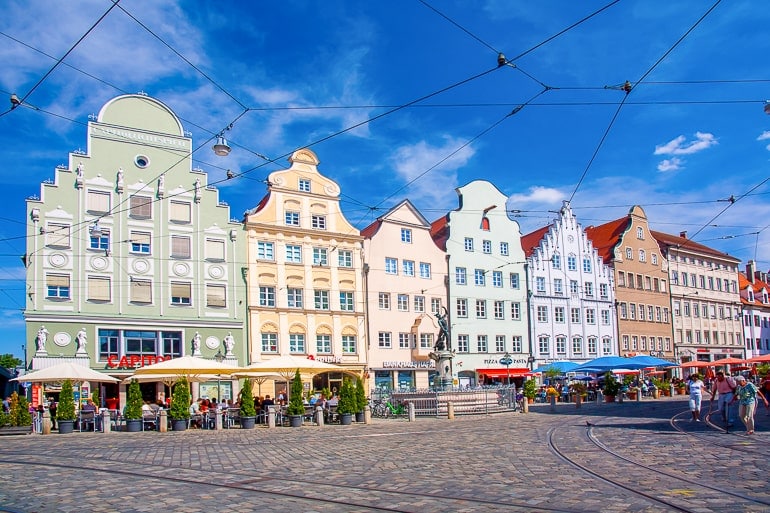
On day 12 you’ll be on your way from Stuttgart to Augsburg, a small city in Bavaria and one of Germany’s oldest cities. Around Germany, most people have heard of Augsburg because of its “Fuggerei” – a historic social housing complex where rent has increased very slowly over the centuries. It’s certainly worth a visit!
It’ll take you around 2 hrs by car to get from Stuttgart to Augsburg. If you opt for the train, then you can expect the journey to take approx. 1 hr 40 minutes.
Accommodation in Augsburg: In Augsburg, you will find a number of places to stay around the city centre. You can check here for accommodations and hotels in Augsburg.
For a reliable stay, check out Hotel Augusta. This popular hotel – located right in the city centre – features breakfast and has parking available if you are travelling to Augsburg by car.
The nice thing about Augsburg is that because it’s a smaller city, you can easily walk to the hotel from the train station if you are arriving by train.
You might also check out City Hotel Ost am Kö which is another hotel in the heart of the centre walkable to the station. It also has breakfast and parking garage right nearby.
Must-see Attractions in Augsburg:
- Augsburg Cathedral
- Fuggerei
- Perlach Tower
Day 13+14: Munich
On your second to last day of this itinerary you will drive from Augsburg to Munich. That’s the last stop on your two week Germany adventure. In Munich, there is more than enough to see to spend two days in the city.
Munich also has an airport with good international connections in case you’re coming from overseas and need to take a plane to get back home. If that’s not the case, we’d encourage you to see whether the train would be an alternative to get you back home as well.
The journey from Augsburg to Munich should take just less than 1 hr by car and between 30 and 48 minutes by train. So it’s certainly one of the shortest transitions mentioned in this article.
Accommodation in Munich: If you’re exploring Munich while in Germany, there is no shortage of places to stay and areas to check out. You can check here for accommodations and hotels in Munich. For this itinerary, remember to book your Munich accommodation for two nights.
We really liked our stay at the H2 Hotel München Olympiapark. From the really good breakfast, nice rooms, and excellent location with metro access nearby – you cannot beat the price for Munich. There’s also parking available if you’re travelling with a car to Munich.
For a spot right in the heart of Munich’s charming old town, check out the Platzl Hotel Superior. This is a trendy hotel that puts you super close to all the action at busy Marienplatz and is steps from Hofbräuhaus, the beer hall made famous decades ago. You can also catch the metro or walk to the central train station from here.
If you are looking for more details on accommodations in this city, we wrote a detailed guide on where to stay in Munich.
Must-see Attractions in Munich:
- Marienplatz with New Town Hall
- Olympic Park
- Victuals Market
- English Garden
To learn more about the city – as we have mentioned before – check out our post on Munich in a day if you want more details about the city!
And there you have it – one massive Germany guide with more than one Germany itinerary to suit your travel needs! Whether you’re looking for a short 5 day or a wild 14 day itinerary – we’re sure you’ll have a great time exploring Germany. We’re actually really happy to have created this post – Lisa especially. It’s always fun to help others explore your home country!
As always, Happy Germany Itinerary Waddlin’,
– L&E
Pin it for later!
